Probability
Question 1. Given that E and F are events such that P(E)=0.6, P(F)=0.3 and \(\mathrm{P}(\mathrm{E} \cap \mathrm{F})=0.2\), find \(\mathrm{P}(\mathrm{E} \mid \mathrm{F})\) and \(P(F \mid E)\).
Solution:
It is given that P(E)=0.6, P(F)=0.3, and \(P(E \cap F)=0.2\)
⇒ \(P(E \mid F)=\frac{P(E \cap F)}{P(F)}=\frac{0.2}{0.3}=\frac{2}{3}\)
⇒ \(P(F \mid E)=\frac{P(F \cap E)}{P(E)}=\frac{0.2}{0.6}=\frac{1}{3}\)
Question 2. Compute \(\mathrm{P}(\mathrm{A} \mid \mathrm{B})\), if \(\mathrm{P}(\mathrm{B})=0.5\) and \(\mathrm{P}(\mathrm{A} \cap \mathrm{B})=0.32\)
Solution:
It is given that P(B)=0.5 and \(P(A \cap B)=0.32 \Rightarrow P\left(\frac{A}{B}\right)=\frac{P(A \cap B)}{P(B)}=\frac{0.32}{0.5}=\frac{16}{25}\)
Question 3. If P(A)=0.8, P(B)=0.5 and \(P(B \mid A)=0.4\), find
- \(\mathrm{P}(\mathrm{A} \cap \mathrm{B})\)
- \(\mathrm{P}(\mathrm{A} \mid \mathrm{B})\)
- \(\mathrm{P}(\mathrm{A} \cup \mathrm{B})\)
Solution:
It is given that P(A)=0.8, P(B)=0.5, and \(P(B \mid A)=0.4\)
1. \(\mathrm{P}(\mathrm{B} \mid \mathrm{A})=0.4\)
∴ \(\frac{P(B \cap A)}{P(A)}=0.4\)
(because \(\mathrm{P}\left(\frac{\mathrm{B}}{\mathrm{A}}\right)=\frac{\mathrm{P}(\mathrm{B} \cap \mathrm{A})}{\mathrm{P}(\mathrm{A})}\))
∴ \(\frac{\mathrm{P}(\mathrm{A} \cap \mathrm{B})}{0.8}=0.4 \Rightarrow \mathrm{P}(\mathrm{A} \cap \mathrm{B})=0.32\)
(because \(B \cap A=A \cap B\))
2. \(\mathrm{P}(\mathrm{A} \mid \mathrm{B})=\frac{\mathrm{P}(\mathrm{A} \cap \mathrm{B})}{\mathrm{P}(\mathrm{B})}\)
(because \(\mathrm{P}\left(\frac{\mathrm{A}}{\mathrm{B}}\right)=\frac{\mathrm{P}(\mathrm{A} \cap \mathrm{B})}{\mathrm{P}(\mathrm{B})}\))
⇒ \(\mathrm{P}(\mathrm{A} \mid \mathrm{B})=\frac{0.32}{0.5}=0.64\)
3. \(\mathrm{P}(\mathrm{A} \cup \mathrm{B})=\mathrm{P}(\mathrm{A})+\mathrm{P}(\mathrm{B})-\mathrm{P}(\mathrm{A} \cap \mathrm{B}) \Rightarrow \mathrm{P}(\mathrm{A} \cup \mathrm{B})=0.8+0.5-0.32=0.98\)
Read and Learn More Class 12 Maths Chapter Wise with Solutions
Question 4. Evaluate \(\mathrm{P}(\mathrm{A} \cup \mathrm{B})\), if 2P(A)=P(B)=\(\frac{5}{13}\) and \(\mathrm{P}(\mathrm{A} \mid \mathrm{B})=\frac{2}{5}\)
Solution:
It is given that, \(2 P(A)=P(B)=\frac{5}{13} \Rightarrow P(A)=\frac{5}{26}\) and \(P(B)=\frac{5}{13}\)
Now, \(\mathrm{P}(\mathrm{A} \mid \mathrm{B})=\frac{2}{5} \Rightarrow \frac{\mathrm{P}(\mathrm{A} \cap \mathrm{B})}{\mathrm{P}(\mathrm{B})}=\frac{2}{5}\)
(because \(\mathrm{P}\left(\frac{\mathrm{A}}{\mathrm{B}}\right)=\frac{\mathrm{P}(\mathrm{A} \cap \mathrm{B})}{\mathrm{P}(\mathrm{B})}\))
⇒ \(\mathrm{P}(\mathrm{A} \cap \mathrm{B})=\frac{2}{5} \times \mathrm{P}(\mathrm{B})=\frac{2}{5} \times \frac{5}{13}=\frac{2}{13}\)
It is known that, \(\mathrm{P}(\mathrm{A} \cup \mathrm{B})=\mathrm{P}(\mathrm{A})+\mathrm{P}(\mathrm{B})-\mathrm{P}(\mathrm{A} \cap \mathrm{B})\)
⇒ \(\mathrm{P}(\mathrm{A} \cup \mathrm{B})=\frac{5}{26}+\frac{5}{13}-\frac{2}{13} \Rightarrow \mathrm{P}(\mathrm{A} \cup \mathrm{B})=\frac{5+10-4}{26} \Rightarrow \mathrm{P}(\mathrm{A} \cup \mathrm{B})=\frac{11}{26}\)
Question 5. If \(P(A)=\frac{6}{11}, P(B)=\frac{5}{11}\) and \(P(A \cup B)=\frac{7}{11}\), find
- \(\mathrm{P}(\mathrm{A} \cap \mathrm{B})\)
- \(\mathrm{P}(\mathrm{A} \mid \mathrm{B})\)
- \(\mathrm{P}(\mathrm{B} \mid \mathrm{A})\)
Solution:
It is given that \(P(A)=\frac{6}{11}, P(B)=\frac{5}{11}\) and \(P(A \cup B)=\frac{7}{11}\)
1. P(A ∪ B)=\(\frac{7}{11}\) (because \(P(A \cup B)=P(A)+P(B)-P(A \cap B)\))
∴ \(P(A)+P(B)-P(A \cap B)=\frac{7}{11}\)
⇒ \(\frac{6}{11}+\frac{5}{11}-P(A \cap B)=\frac{7}{11}\)
⇒ \(P(A \cap B)=\frac{11}{11}-\frac{7}{11}=\frac{4}{11}\)
2. It is known that, \(\mathrm{P}(\mathrm{A} \mid \mathrm{B})=\frac{\mathrm{P}(\mathrm{A} \cap \mathrm{B})}{\mathrm{P}(\mathrm{B})} \Rightarrow \mathrm{P}(\mathrm{A} \mid \mathrm{B})=\frac{\frac{4}{11}}{\frac{5}{11}}=\frac{4}{5}\)
3. It is known that, \(\mathrm{P}(\mathrm{B} \mid \mathrm{A})=\frac{\mathrm{P}(\mathrm{B} \cap \mathrm{A})}{\mathrm{P}(\mathrm{A})} \Rightarrow \mathrm{P}(\mathrm{B} \mid \mathrm{A})=\frac{\frac{4}{11}}{\frac{6}{11}}=\frac{4}{6}=\frac{2}{3}\)
Determine P(E | F)
Question 6. A coin is tossed three times, where
- E: head on third toss, F: heads on first two tosses
- E: at least two heads, F: at most two heads
- E: at most two tails, F: at least one tail
Solution:
If a coin is tossed three times, then the sample space S is S = {HHH, HHT, HTH, HTT, THH, THT, TTH, TTT}
⇒ n(S) = 8
1. E = {HHH, HTH, THH, TTH}
F = {HHH, HHT}
∴ E ∩ F = {HHH}
∴ P(F) = \(\frac{2}{8}=\frac{1}{4} \text { and } P(E \cap F)=\frac{1}{8}\)
∴ \(P(E \mid F)=\frac{P(E \cap F)}{P(F)}=\frac{\frac{1}{8}}{\frac{1}{4}}=\frac{4}{8}=\frac{1}{2}\)
2. E = {HHH, HHT, HTH, THH}
F = {HHT, HTH, HTT, THH, THT, TTH, TTT}
∴ E ∩ F = {HHT, HTH, THH}
Clearly, \(\mathrm{P}(\mathrm{E} \cap \mathrm{F})=\frac{3}{8}\) and \(\mathrm{P}(\mathrm{F})=\frac{7}{8}\)
∴ \(\mathrm{P}(\mathrm{E} \mid \mathrm{F})=\frac{\mathrm{P}(\mathrm{E} \cap \mathrm{F})}{\mathrm{P}(\mathrm{F})}=\frac{\frac{3}{8}}{\frac{7}{8}}=\frac{3}{7}\)
3. E = {HHH, HHT, HTT, HTH, THH, THT, TTH}
F = {HHT, HTT, HTH, THH, THT, TTH, TTT}
∴ E ∩ F = {HHT, HTT, HTH, THH, THT, TTH}
⇒ \(\mathrm{P}(\mathrm{F})=\frac{7}{8}\) and \(\mathrm{P}(\mathrm{E} \cap \mathrm{F})=\frac{6}{8}\)
Therefore, \(\mathrm{P}(\mathrm{E} \mid \mathrm{F})=\frac{\mathrm{P}(\mathrm{E} \cap \mathrm{F})}{\mathrm{P}(\mathrm{F})}=\frac{\frac{6}{8}}{\frac{8}{8}}=\frac{6}{7}\)

Question 7. Two coins are tossed once, where:
- E: tail appears on one coin, F: one coin shows the head
- E: no tail appears, F: no head appears
Solution:
If two coins are tossed once, then the sample space S is S = {HH, HT, TH, TT}
1. E = {HT, TH}, F = {HT, TH}
∴ E ∩ F = {HT, TH}
⇒ \(\mathrm{P}(\mathrm{F})=\frac{2}{4}=\frac{1}{2}\)
∴ \(\mathrm{P}(\mathrm{E} \cap \mathrm{F})=\frac{2}{4}=\frac{1}{2} \Rightarrow \mathrm{P}(\mathrm{E} \mid \mathrm{F})=\frac{\mathrm{P}(\mathrm{E} \cap \mathrm{F})}{\mathrm{P}(\mathrm{F})}=\frac{\frac{1}{2}}{\frac{1}{2}}=1\)
2. E = {HH} [Set of events having no tail]
F = {TT} [Set of events having no head]
∴ \(E \cap F=\phi\)
P(E) = \(\frac{1}{4}, P(F)=\frac{1}{4}\) and \(P(E \cap F)=0\)
∴ \(P(E \mid F)=\frac{P(E \cap F)}{P(F)}=\frac{0}{1 / 4}=0\)
Question 8. A die is thrown three times, E: 4 appears on the third toss, F: 6 and 5 appear respectively on the first two tosses
Solution:
If a die is thrown three times, then the number of elements in the sample space will be 6x6x6 = 216 The sample space is S = {(x, y, z): x, y, z ∈ 1,2, 3, 4, 5, 6}
E = \(\left\{\begin{array}{l}
(1,1,4),(1,2,4), \ldots . .(1,6,4) \\
(2,1,4),(2,2,4), \ldots \ldots(2,6,4) \\
(3,1,4),(3,2,4), \ldots \ldots(3,6,4) \\
(4,1,4),(4,2,4), \ldots \ldots(4,6,4) \\
(5,1,4),(5,2,4), \ldots \ldots(5,6,4) \\
(6,1,4),(6,2,4), \ldots \ldots . .(6,6,4)
\end{array}\right\} \Rightarrow n(E)=36\)
F = {(6, 5, 1), (6, 5, 2), (6, 5, 3), (6, 5, 4), (6, 5, 5), (6, 5, 6)}
∴ \(E \cap F=\{(6,5,4)\} \Rightarrow n(E \cap F)=1\)
P(F) = \(\frac{6}{216} \text { and } P(E \cap F)=\frac{1}{216}\)
⇒ \(P(E \mid F)=\frac{P(E \cap F)}{P(F)}=\frac{\frac{1}{6}}{\frac{216}{216}}=\frac{1}{6}\)
Question 9. Mother, father, and son line up at random for a family picture, E: son on one end, F: father in middle.
Solution:
If the mother (M), father (F), and son (S) line up for the family picture, then the sample space will be S = {MFS, MSF, FMS, FSM, SMF, SFM}
⇒ E = (MFS, FMS, SMF, SFM}, F = (MFS, SFM} => E n F = (MFS, SFM} = 2
⇒ \(P(E \cap F)=\frac{2}{6}=\frac{1}{3} \text { and } P(F)=\frac{2}{6}=\frac{1}{3} \Rightarrow P(E \mid F)=\frac{P(E \cap F)}{P(F)}=\frac{\frac{1}{3}}{\frac{1}{3}}=1\)
Question 10. A black and a red dice are rolled.
- Find the conditional probability of obtaining a sum greater than 9, given that the black die resulted in a 5.
- Find the conditional probability of obtaining the sum 8, given that the red die resulted in a number less than 4.
Solution:
Let the first observation be from the black die and the second from the red die. When two dice (one black and another red) are rolled, the sample space S = 6 x 6 = 36 number of elements.
1. Let A: Obtaining a sum greater than 9 = {(4, 6), (5. 5), (5, 6), (6, 4), (6, 5), (6, 6)}
B: Black die results in a 5 = {(5, 1), (5,2), (5, 3), (5,4), (5, 5), (5, 6)}
∴ A ∩ B= {(5, 5), (5, 6)}
The conditional probability of obtaining a sum greater than 9, given that the black die resulted in a 5, is given by P (A|B).
∴ P(A|B) = \(\frac{\mathrm{P}(\mathrm{A} \cap \mathrm{B})}{\mathrm{P}(\mathrm{B})}=\frac{\frac{2}{36}}{\frac{6}{36}}=\frac{2}{6}=\frac{1}{3}\)
2. E: Sum of the observations is 8 = {(2, 6), (3, 5), (4, 4), (5, 3), (6, 2)}
F: Red die resulted in a number less than 4 = \(\left\{\begin{array}{l}
(1,1),(1,2),(1,3),(2,1),(2,2),(2,3), \\
(3,1),(3,2),(3,3),(4,1),(4,2),(4,3), \\
(5,1),(5,2),(5,3),(6,1),(6,2),(6,3)
\end{array}\right\}\)
∴ E ∩ F = {(5, 3),(6, 2)}
P(F) = 18/36 and P(E n F) = 2/36
The conditional probability of obtaining the sum equal to 8, given that the red die resulted in a number less than 4, is given by P (E | F).
Therefore, \(P(E \mid F)=\frac{P(E \cap F)}{P(F)}=\frac{\frac{2}{36}}{\frac{18}{36}}=\frac{2}{18}=\frac{1}{9}\)
Question 11. A fair die is rolled. Consider events E = {1, 3, 5}, F = {2, 3} and G = (2, 3,4, 5}. Find
- P(E | F) and P(F | E)
- P(E | G) and P(G | E)
- P((E ∪ F) | G) and P ((E ∩ F) | G)
Solution:
When a fair die is rolled, the sample space S will be S = {1,2,3, 4, 5, 6)
It is given that E = {1, 3, 5}, F = z[2, 3}, and G = {2, 3, 4, 5}
∴ P(E) = \(\frac{3}{6}=\frac{1}{2}, P(F)=\frac{2}{6}=\frac{1}{3}, P(G)=\frac{4}{6}=\frac{2}{3}\)
1. \(\mathrm{E} \cap \mathrm{F}=\{3\} \Rightarrow \mathrm{P}(\mathrm{E} \cap \mathrm{F})=\frac{1}{6}\)
∴ \(\mathrm{P}(\mathrm{E} \mid \mathrm{F})=\frac{\mathrm{P}(\mathrm{E} \cap \mathrm{F})}{\mathrm{P}(\mathrm{F})}=\frac{\frac{1}{6}}{\frac{1}{3}}=\frac{1}{2} ; \mathrm{P}(\mathrm{F} \mid \mathrm{E})=\frac{\mathrm{P}(\mathrm{F} \cap \mathrm{E})}{\mathrm{P}(\mathrm{E})}=\frac{\frac{1}{6}}{\frac{1}{2}}=\frac{1}{3}\)
2. \(\mathrm{E} \cap \mathrm{G}=\{3,5\}\)
∴ \(\mathrm{P}(\mathrm{E} \cap \mathrm{G})=\frac{2}{6}=\frac{1}{3}\)
∴ \(P(E \mid G)=\frac{P(E \cap G)}{P(G)}=\frac{\frac{1}{3}}{\frac{2}{3}}=\frac{1}{2} ; P(G \mid E)=\frac{P(G \cap E)}{P(E)}=\frac{\frac{1}{3}}{\frac{1}{2}}=\frac{2}{3}\)
3. \(\mathrm{P} \cup \mathrm{F}=\{1,2,3,5\}\)
⇒ \((\mathrm{E} \cup \mathrm{F}) \cap \mathrm{G}=\{1,2,3,5\} \cap\{2,3,4,5\}=\{2,3,5\}\)
⇒ \(\mathrm{E} \cap \mathrm{F}=\{3\}\)
⇒ \((\mathrm{E} \cap \mathrm{F}) \cap \mathrm{G}=\{3\} \cap\{2,3,4,5\}=\{3\}\)
⇒ \(P((\mathrm{E} \cup \mathrm{F}) \cap \mathrm{G})=\frac{3}{6}=\frac{1}{2}, \mathrm{P}((\mathrm{E} \cap \mathrm{F}) \cap \mathrm{G})=\frac{1}{6}\)
∴ \(\mathrm{P}((\mathrm{E} \cap \mathrm{F}) \mid \mathrm{G})=\frac{\mathrm{P}((\mathrm{E} \cap \mathrm{F}) \cap \mathrm{G})}{\mathrm{P}(\mathrm{G})}=\frac{\frac{1}{6}}{\frac{2}{3}}=\frac{1}{6} \times \frac{3}{2}=\frac{1}{4}\)
Question 12. Assume that each bom child is equally likely to be a boy or a girl. If a family has two children, what is the conditional probability that both are girls given that
- The youngest is a girl,
- At least one is a girl?
Solution:
Let b and g represent the boy and the girl child respectively. If a family has two children, the sample space will be
S = {(b, b), (b, g), (g, b), (g, g)}
Let A be the event that both children are girls.
∴ A={(g,g)}
1. Let B be the event that the youngest child is a girl.
∴ B = [(b, g), (g, g)] ⇒ A ∩ B = {(g, g)}
∴ \(P(B)=\frac{2}{4}=\frac{1}{2}, \quad P(A \cap B)=\frac{1}{4}\)
The conditional probability that both are girls, given that the youngest child is a girl, is given by P (A | B).
⇒ \(\mathrm{P}(\mathrm{A} \mid \mathrm{B})=\frac{\mathrm{P}(\mathrm{A} \cap \mathrm{B})}{\mathrm{P}(\mathrm{B})}=\frac{\frac{1}{4}}{\frac{1}{2}}=\frac{1}{2}\)
Therefore, the required probability is 1/2.
2. Let C be the event that at least one child is a girl.
∴ C = {(b, g), (g,b), (g, g)} ⇒ A ∩ C = {g, g} ⇒ P(C) = 3/4
⇒ P(A ∩ C) = 1/4
The conditional probability that both are girls, given that at least one child is a girl, is given by P(A|C).
Therefore. P(A C) = \(P(A \mid C)=\frac{P(A \cap C)}{P(C)}=\frac{\frac{1}{4}}{\frac{3}{4}}=\frac{1}{3}\)
Question 13. An instructor has a question bank consisting of 300 easy True/False questions, 200 difficult True/False questions, 500 easy multiple choice questions, and 400 difficult multiple choice questions. If a question is selected at random from the question bank, what is the probability that it will be an easy question given that it is a multiple-choice question?
Solution:
The given data can be tabulated as
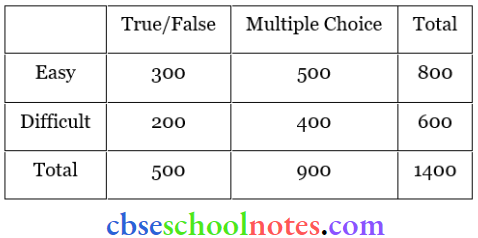
Let us denote E = easy questions, M = multiple choice questions, D = difficult questions, and T = True/False questions
Total number of questions = 1400
Total number of multiple choice questions = 900
Therefore, the probability of selecting an easy multiple choice question is \(P(E \cap M)=\frac{500}{1400}=\frac{5}{14}\)
Probability of selecting a multiple choice question, \(P(M)=\frac{900}{1400}=\frac{9}{14}\)
P (E | M) represents the probability that a randomly selected question will be an easy question, given that it is a multiple-choice question.
∴ \(\mathrm{P}(\mathrm{E} \mid \mathrm{M})=\frac{\mathrm{P}(\mathrm{E} \cap \mathrm{M})}{\mathrm{P}(\mathrm{M})}=\frac{\frac{-5}{14}}{\frac{9}{14}}=\frac{5}{9}\)
Therefore, the required probability is 5/9
Question 14. Given that the two numbers appearing on throwing the two dice are different. Find the probability of the event ‘the sum of numbers on the dice is 4.
Solution:
When two dice are thrown, the number of observations in the sample space = 6 x 6 = 36
Let A be the event that the sum of the numbers on both dice is 4 and B be the event that the two numbers appearing on throwing the two dice are different.
∴ A ={(1,3), (2, 2), (3,1)}
⇒ n(A) = 3
B = \(\left\{\begin{array}{l}
(1,2),(1,3),(1,4),(1,5),(1,6) \\
(2,1),(2,3),(2,4),(2,5),(2,6) \\
(3,1),(3,2),(3,4),(3,5),(3,6) \\
(4,1),(4,2),(4,3),(4,5),(4,6) \\
(5,1),(5,2),(5,3),(5,4),(5,6) \\
(6,1),(6,2),(6,3),(6,4),(6,5)
\end{array}\right\}=n(B)=30\)
∴ \(A \cap B=\{(1,3),(3,1)\}\)
⇒ P(B) = \(\frac{30}{36}=\frac{5}{6} \text { and } P(A \cap B)=\frac{2}{36}=\frac{1}{18}\)
Let \(\mathrm{P}(\mathrm{A} \mid \mathrm{B})\) represent the probability that the sum of the numbers on both dice is 4, given that the two numbers appearing on throwing the two dice are different.
∴ \(\mathrm{P}(\mathrm{A} \mid \mathrm{B})=\frac{\mathrm{P}(\mathrm{A} \cap \mathrm{B})}{\mathrm{P}(\mathrm{B})}=\frac{\frac{1}{18}}{\frac{5}{6}}=\frac{1}{15}\)
Therefore, the required probability is \(\frac{1}{15}\).
Question 15. Consider the experiment of throwing a die, if a multiple of 3 comes up, throw the die again and if any other number comes, toss a coin. Find the conditional probability of the event ‘the coin shows a tail’, given that at least one die shows a 3.
Solution:
The sample space of the experiment is,
S = \(\left\{\begin{array}{l}
(1, H),(1, T),(2, H),(2, T),(3,1),(3,2),(3,3),(3,4),(3,5),(3,6) \\
(4, H),(4, T),(5, H),(5, T),(6,1),(6,2),(6,3),(6,4),(6,5),(6,6)
\end{array}\right\}\)
Let A be the event that the coin shows a tail and B be the event that at least one die shows 3.
∴ A = {(1, T), (2, T), (4, T), (5, T)}
B = {(3,1), (3, 2), (3, 3), (3, 4), (3, 5), (3, 6), (6, 3)}
⇒ A ∩ B = ø
∴ P(A ∩ B) = 0
because there are no common elements.
Then, P(B) =P({3,1}) + P({3,2}) + P({3,3}) + P({3,4}) + P({3,5}) + P({3,6}) + P({6,3})
= \(\frac{1}{36}+\frac{1}{36}+\frac{1}{36}+\frac{1}{36}+\frac{1}{36}+\frac{1}{36}+\frac{1}{36}=\frac{7}{36}\)
The probability of the event that the coin shows a tail, given that at least one die shows 3, is given by P(A | B).
Therefore. \(P(A \mid B)=\frac{P(A \cap B)}{P(B)}=\frac{0}{\frac{7}{36}}=0\)
Choose The Correct Answer
Question 16. If P(A) = \(\frac{1}{2}\), P(B) = 0, then P(A | B) is
- 0
- \(\frac{1}{2}\)
- Not Defined
- 1
Solution: 3. Not defined
It is given that P(A) = \(\frac{1}{2}\) and P(B) = 0
P\((A \mid B)=\frac{P(A \cap B)}{P(B)}=\frac{P(A \cap B)}{0}\)
Therefore, P (A | B) is not defined.
Thus, the correct Answer is 3.
Question 17. If A and B are events such that P (A | B) = P(B | A), then
- A ⊂ B but A ≠ B
- A = B
- A ∩ B = ø
- P(A) = P(B)
Solution: 4. P(A) = P(B)
It is given that, P(A | B) = P(B | A)
⇒ \(\frac{P(A \cap B)}{P(B)}=\frac{P(B \cap A)}{P(A)}\)
⇒ P(A)=P(B)
Thus, the correct Answer is 4.
Probability Exercise 13.2
Question 1. If P(A) = \(\frac{3}{5}\) and P(B) = \(\frac{1}{5}\), find P (A ∩ B) if A and B are independent events.
Solution:
It is given that P(A) = \(\frac{3}{5}\) and P(B) = \(\frac{1}{5}\)
A and B are independent events. Therefore, P(A ∩ B) = P(A)P(B) = \(\frac{3}{5}\) \(\frac{1}{5}\) = \(\frac{3}{25}\)
Question 2. Two cards are drawn at random and without replacement from a pack of 52 playing cards. Find the probability that both the cards are black.
Solution:
There are 26 black cards in a deck of 52 cards.
Let A: event that 1st card is black, B: event that 2nd card is black.
P(getting a black card in the first draw) = P(A) = \(\frac{26}{52}\) = \(\frac{1}{2}\)
P (getting a black card on the second draw) – P(B/A) = \(\frac{25}{51}\) (v card is not replaced)
Thus, P(getting both the cards black) = P(A ∩ B) = P(A).P(B/A) = \(\frac{1}{2}\) x \(\frac{25}{51}\) = \(\frac{25}{102}\)
Question 3. A box of oranges is inspected by examining three randomly selected oranges drawn without replacement. If all three oranges are good, the box is approved for sale, otherwise, it is rejected. Find the probability that a box containing 15 oranges out of which 12 are good and 3 are bad ones will be approved for sale.
Solution:
Let A, B, and C be the events respectively that the first, second, and third drawn orange is good.
Therefore, probability that lust drawn orange is good, P(A) = \(\frac{12}{15}\)
Since the second orange is drawn without replacement (now the total number of good oranges will be 11 and the total oranges will be 14
∴ The conditional probability of B, given that A has already occurred is P(B/A) ⇒ P(B/A) = \(\frac{11}{14}\)
Again, the third orange is drawn without replacement (now the total number of good oranges will be 10, and the total number of oranges will be 13).
∴ The conditional probability of C, given that A and B have already occurred is P(C/AB)
⇒ P(C/AB)= \(\frac{10}{13}\)
The box is approved for sale if all three oranges are good.
Thus, the probability of getting all the oranges good
= P(A ∩ B ∩ C) = P(A). P(B/A). P(C/AB) = \(\frac{12}{15}\) x \(\frac{11}{14}\) x \(\frac{10}{3}\) = \(\frac{44}{91}\)
Therefore, the probability that the box is approved for sale is \(\frac{44}{91}\)
Question 4. A fair coin and an unbiased die are tossed. Let A be the event ‘head appears on the coin’ and B be the event ‘3 on the die’. Check whether A and B are independent events or not.
Solution:
If a fair coin and an unbiased die are tossed, then the sample space S is given by,
S = \(\left\{\begin{array}{l}
(\mathrm{H}, 1),(\mathrm{H}, 2),(\mathrm{H}, 3),(\mathrm{H}, 4),(\mathrm{H}, 5),(\mathrm{H}, 6) \\
(\mathrm{T}, 1),(\mathrm{T}, 2),(\mathrm{T}, 3),(\mathrm{T}, 4),(\mathrm{T}, 5),(\mathrm{T}, 6)
\end{array}\right\} \Rightarrow \mathrm{n}(\mathrm{S})=12\)
Let A: Head appears on the coin
A = {(H, 1), (H, 2), (H, 3), (H, 4), (H, 5), (H, 6)}
⇒ P(A) = \(\frac{6}{12}\) = \(\frac{1}{2}\)
B: 3 on die = {(H, 3), (T, 3)}
P(B) = \(\frac{2}{12}\) = \(\frac{1}{6}\)
∴ A∩B = {(H, 3)}
P(A∩B) = \(\frac{1}{12}\)
Also, P(A)·P(B) =\(\frac{1}{2}\) x \(\frac{1}{6}\) =\(\frac{1}{12}\) = P(A∩B)
Therefore, A and B are independent events.
Question 5. A die marked 1, 2, 3 in red and 4, 5, 6 in green is tossed. Let A be the event, ‘the number is even,’ and B be the event, ‘the number is red’. Are A and B independent?
Solution:
When a die is thrown, the sample space (S) is S = {1, 2, 3, 4, 5, 6}
Let A: the number is even = {2, 4, 6} ⇒ P(A) = \(\frac{3}{6}\) = \(\frac{1}{2}\)
B: the number is red = {1,2, 3} ⇒ P(B) = \(\frac{3}{6}\) = \(\frac{1}{2}\)
∴ A∩B = {2} ⇒ P(A∩B) = \(\frac{1}{6}\)
Also, P(A)·P(B) = \(\frac{1}{2}\) x \(\frac{1}{2}\) = \(\frac{1}{4}\)≠\(\frac{1}{6}\)≠P(A∩B)
⇒ P(A) · P(B) ≠ P(A∩B)
Therefore, A and B are not independent.
Question 6. Let E and F be events withP(E) = \(\frac{3}{5}\), P(F) = \(\frac{3}{10}\) and P(E∩F) = \(\frac{1}{5}\). Are E and F independent?
Solution:
It is given that P(E) = \(\frac{3}{5}\), P(F) = \(\frac{3}{10}\) and P(E∩F) = \(\frac{1}{5}\)
Now, P(E) · P(F) = \(\frac{3}{5} \cdot \frac{3}{10}=\frac{9}{50} \neq \frac{1}{5} \Rightarrow \mathrm{P}(\mathrm{E} \cap \mathrm{F}) \Rightarrow \mathrm{P}(\mathrm{E}) \cdot \mathrm{P}(\mathrm{F}) \neq \mathrm{P}(\mathrm{E} \cap \mathrm{F})\)
Therefore, E and F are not independent.
Question 7. Given that the events A and B are such that P(A) = \(\frac{1}{2}\), P(A∪B) = \(\frac{3}{5}\) and P(B) = p. Find p if they are
- Mutually exclusive
- Independent
Solution:
It is given that P(A) = \(\frac{1}{2}\), P(A∪B) = \(\frac{3}{5}\) and P(B) = p
1. When A and B are mutually exclusive, A∩B = ø
∴ P(A∩B) = 0
It is known that, P(A∪B) = P(A) + P(B) – P(A∩B)
2. When A and B are independent, events then, P(A∩B) = P(A)·P(B) = \(\frac{1}{2}\) p
It is known that, P(A∩B) = P(A) + P(B) – P(A∩B)
⇒ \(\frac{3}{5}=\frac{1}{2}+\mathrm{p}-\frac{1}{2} \mathrm{p} \Rightarrow \frac{3}{5}=\frac{1}{2}+\frac{\mathrm{p}}{2}\)
⇒ \(\frac{\mathrm{p}}{2}=\frac{3}{5}-\frac{1}{2}=\frac{1}{10} \Rightarrow \mathrm{p}=\frac{2}{10}=\frac{1}{5}\)
Question 8. Let A and B be independent events with P(A) = 0.3 and P(B) = 0.4. Find
- (P(A∩B),
- P(A∪B),
- P(A|B),
- P(B|A)
Solution:
It is given that P(A) = 0.3 and P(B) = 0.4
- If A and B are independent events, then P(A∩B) = P(A)·P(B) = 0.3 x 0.4 = 0.12
- P(A∪B) = P(A) + P(B)-P(A∩B) ⇒ P(A∪B) = 0.3 + 0.4 – 0.12 = 0.58
- It is known that, P(A | B) = \(\frac{P(A \cap B)}{P(B)} \Rightarrow P(A \mid B)=\frac{0.12}{0.4}=0.3\)
- It is known that, P(B | A) = \(\frac{\mathrm{P}(\mathrm{B} \cap \mathrm{A})}{\mathrm{P}(\mathrm{A})} \Rightarrow \mathrm{P}(\mathrm{B} \mid \mathrm{A})=\frac{0.12}{0.3}=0.4\)
Question 9. If A and B are two events such that P(A) = \(\frac{1}{2}\), P(B) = \(\frac{1}{2}\) and P(A∩B) = \(\frac{1}{8}\), find P(not A and not B).
Solution:
It is given that P(A) = \(\frac{1}{4}\), P(B) = \(\frac{1}{2}\) and P(A∩B) = \(\frac{1}{8}\)
P(not A and not B) = P(A’∩B’)
P(not A and not B) = p((A∪B)’) [A’∩B’ = (A∪B)’]
= \(1-P(A \cup B)=1-[P(A)+P(B)-P(A \cap B)]\)
= \(1-\left[\frac{1}{4}+\frac{1}{2}-\frac{1}{8}\right]=1-\frac{5}{8}=\frac{3}{8}\)
Question 10. Events A and B are such that P(A) = \(\frac{1}{2}\), P(B) = \(\frac{7}{12}\) and P(not A or not B) = \(\frac{1}{4}\). State whether A and B are independent.
solution:
It is given that \(P(A)=\frac{1}{2}, P(B)=\frac{7}{12}\) and P(not A or not B)= \(\frac{1}{4}\).
⇒ \(\mathrm{P}\left(\mathrm{A}^{\prime} \cup \mathrm{B}^{\prime}\right)=\frac{1}{4}\)
⇒ \(\mathrm{P}\left((\mathrm{A} \cap \mathrm{B})^{\prime}\right)=\frac{1}{4}\)
(because \(\mathrm{A}^{\prime} \cup \mathrm{B}^{\prime}=(\mathrm{A} \cap \mathrm{B})^{\prime}\))
⇒ 1-\(\mathrm{P}(\mathrm{A} \cap \mathrm{B})=\frac{1}{4} \Rightarrow \mathrm{P}(\mathrm{A} \cap \mathrm{B})=\frac{3}{4}\)….(1)
However, \(\mathrm{P}(\mathrm{A}) \cdot \mathrm{P}(\mathrm{B})=\frac{1}{2} \cdot \frac{7}{12}=\frac{7}{24}\)
Here, \(\frac{3}{4} \neq \frac{7}{24}\)…..(2)
∴ \(P(A \cap B) \neq P(A) \cdot P(B)\)
Therefore, A and B are not independent events.
Question 11. Given two independent events A and B such that P (A) = 0.3, P (B) = 0.6. Find
- P(A and B)
- P(A and not B)
- P(A or B)
- P(neither A nor B)
Solution:
It is given that P (A) = 0.3 and P (B) = 0.6
Also, A and B are independent events.
- P(A and B) = P(A)·P(B) ⇒ P(A∩B) = 0.3 x 0.6 = 0.18
- P(A and not B) – P(A∩B’) = P(A) – P(A∩B) = 0.3 – 0.18 = 0.12
- P(A or B) = P(A∪B) = P(A) + P(B) – P(A∩B) = 0.3 + 0.6 – 0.18 = 0.72
- P(neither A nor B) = P(A’∩B’) = P((A∪B)’) = 1 – P(A∪B) = 1- 0.72 = 0.28
Question 12. A die is tossed thrice. Find the probability of getting an odd number at least once.
Solution:
Probability of getting an odd number in a single throw of a die = \(\frac{3}{6}\) = \(\frac{1}{2}\)
Similarly, probability of getting an even number = \(\frac{3}{6}\) = \(\frac{1}{2}\)
Probability of getting an even number three times = \(\frac{1}{2}\) x \(\frac{1}{2}\) x \(\frac{1}{2}\) = \(\frac{1}{8}\)
Therefore, the probability of getting an odd number at least once
= 1 – Probability of getting an odd number in none of the throws
= 1 – Probability of getting an even number thrice
= 1- \(\frac{1}{8}\) = \(\frac{7}{8}\)
Question 13. Two balls are drawn at random with replacement from a box containing 10 black and 8 red balls. Find the probability that
- Both balls are red.
- The first ball is black and the second is red.
- One of them is black and the other is red.
Solution:
Let R: event that drawn ball is red
B: event that drawn ball is black
∴ P(R) = \(\frac{8}{18}\) = \(\frac{4}{9}\) and P(B) = \(\frac{10}{18}\) = \(\frac{5}{9}\)
1. P(Both balls are red)
= \(P(R \cap R)=P(R) \cdot P(R)\) (Ball is replaced)
= \(\frac{4}{9} \cdot \frac{4}{9}=\frac{16}{81}\)
2. P(first ball is black and second is red) = P(B∩R)
= P(B). P(R) (Ball is replaced)
= \(\frac{5}{9} \cdot \frac{4}{9}=\frac{20}{81}\)
3. P(one of them is black and other red)
= P [(R∩B)∪(B∩R)] = P(R∩B) + P(B∩R)
= P(R). P(B) + P(B). P(R) (Ball is replaced)
= \(\frac{4}{9} \cdot \frac{5}{9}+\frac{5}{9} \cdot \frac{4}{9}=\frac{20}{81}+\frac{20}{81}=\frac{40}{81}\)
Question 14. The probability of solving specific problems independently by A and B are \(\frac{1}{2}\) and \(\frac{1}{3}\) respectively. If both try to solve the problem independently, find the probability that
- The problem is solved
- Exactly one of them solves the problem.
Solution:
Let E1: an event that A solves the problem
E2: an event that B solves the problem
Then \(P\left(E_1\right)=\frac{1}{2}\) and \(P\left(E_1\right)=\frac{1}{3} \Rightarrow P\left(\bar{E}_1\right)=1-\frac{1}{2}=\frac{1}{2}\) and \(P\left(\bar{E}_2\right)=1-\frac{1}{3}=\frac{2}{3}\)
Clearly, \(\mathrm{E}_1\) and \(\mathrm{E}_2\) are independent events :
1. P (the problem is solved)
= \(P(\text { at least one of } A \text { and } B \text { solves the problem })\)
= \(P\left(E_1 \cup E_2\right)=P\left(E_1\right)+P\left(E_2\right)-P\left(E_1 \cap E_2\right)=P\left(E_1\right)+P\left(E_2\right)-P\left(E_1\right), P\left(E_2\right)\)
= \(\frac{1}{2}+\frac{1}{3}-\frac{1}{2} \cdot \frac{1}{3}=\frac{2}{3}\)
2. P(exactly one of them solves the problem)
= \(P\left[\left(E_1 \cap \bar{E}_2\right) \cup\left(\bar{E}_1 \cap E_2\right)\right]\)
= \(P\left(E_1 \cap \bar{E}_2\right)+P\left(\bar{E}_1 \cap E_2\right)\)
= \(P\left(E_1\right) \cdot P\left(\bar{E}_2\right)+P\left(\bar{E}_1\right) \cdot P\left(E_2\right)\)
= \(\frac{1}{2} \times \frac{2}{3}+\frac{1}{3} \times \frac{1}{2}=\frac{1}{2}\)
Question 15. One card is drawn at random from a well-shuffled deck of 52 cards. In which of the following cases are the events E and F independent?
- E: ‘The card drawn is a spade’, F: ‘The card drawn is an ace’
- E: ‘The card drawn is black’, F: ‘The card drawn is a king’
- E: ‘The card drawn is a king or queen’, F: ‘The card drawn is a queen or jack’
Solution:
1. In a deck of 52 cards, 13 cards are spades and 4 cards are aces.
∴ P(E) = P(the card drawn is a spade) = \(\frac{13}{52}\) = \(\frac{1}{4}\)
∴ P(F) = P(the card drawn is an ace) = \(\frac{4}{52}\) = \(\frac{1}{3}\)
In the deck of cards, only 1 card is an ace of spades.
P(E∩F) = P(the card drawn is spade and an ace) = \(\frac{1}{52}\)
⇒ \(\mathrm{P}(\mathrm{E}) \cdot \mathrm{P}(\mathrm{F})=\frac{1}{4} \cdot \frac{1}{13}=\frac{1}{52}=\mathrm{P}(\mathrm{E} \cap \mathrm{F})\)
⇒ \(\mathrm{P}(\mathrm{E}) \cdot \mathrm{P}(\mathrm{F})=\mathrm{P}(\mathrm{E} \cap \mathrm{F})\)
Therefore, the events E and F are independent.
2. In a deck of 52 cards, 26 cards are black and 4 cards are kings.
∴ P(E) = P(the card drawn is black) = \(\frac{26}{52}\) = \(\frac{1}{2}\)
∴ P(F) = P(the card drawn is black) = \(\frac{4}{52}\) = \(\frac{1}{13}\)
In the pack of 52 cards, 2 cards are black as well as kings.
∴ P(E∩F) = P(the card drawn is a black king) = \(\frac{2}{52}\) = \(\frac{1}{26}\)
Also, \(P(E) \times P(F)=\frac{1}{2} \cdot \frac{1}{13}=\frac{1}{26}=P(E \cap F)\)
Therefore, the given events E and F are independent.
3. In a deck of 52 cards, 4 cards are kings, 4 cards are queens, and 4 cards are jacks.
∴ P(E) = P(the card drawn is a king or a queen) = \(\frac{8}{52}\) = \(\frac{2}{13}\)
∴ P(F) = P(the card drawn is a queen or a jack) = \(\frac{8}{52}\) = \(\frac{2}{13}\)
There are 4 cards which are either king or queen and either queen or jack.
∴P(E∩F) = P(the card drawn is either king or queen and either queen or jack) = \(\frac{4}{52}\) = \(\frac{1}{13}\)
Now, \(\mathrm{P}(\mathrm{E}) \times \mathrm{P}(\mathrm{F})=\frac{2}{13} \cdot \frac{2}{13}=\frac{4}{169} \neq \frac{1}{13}\)
⇒ P(E)·P(F) ≠ P(E∩ F)
Therefore, the given events E and F are not independent.
Question 16. In a hostel, 60% of the students read Hindi newspapers, 40% read English newspapers and 20% read both Hindi and English newspapers. A student is selected at random.
- Find the probability that she reads neither Hindi nor English newspapers.
- If she reads a Hindi newspaper, find the probability that she reads an English newspaper.
- If she reads an English newspaper, find the probability that she reads a Hindi newspaper.
Solution:
Let H denote the students who read Hindi newspapers and E denote the students who read English newspapers.
It is given that, P(H)=60 \(\%=\frac{6}{10}=\frac{3}{5} ; \mathrm{P}(\mathrm{E})=40 \%=\frac{40}{100}=\frac{2}{5} ; \mathrm{P}(\mathrm{H} \cap \mathrm{E})=20 \%=\frac{20}{100}=\frac{1}{5}\)
1. The probability that a student reads neither Hindi nor English newspapers is,
⇒ \(\mathrm{P}_{(}\left(\mathrm{H}^{\prime} \cap \mathrm{E}^{\prime}\right)=\mathrm{P}\left(\mathrm{H} \cup \mathrm{E}^{\prime}\right.=1-\mathrm{P}(\mathrm{H} \cup \mathrm{E})=1-\{\mathrm{P}(\mathrm{H})+\mathrm{P}(\mathrm{E})-\mathrm{P}(\mathrm{H} \cap \mathrm{E})\}\)
= \(1-\left(\frac{3}{5}+\frac{2}{5}-\frac{1}{5}\right)=1-\frac{4}{5}=\frac{1}{5}\)
2. The probability that a randomly chosen student reads an English newspaper if she reads a Hindi newspaper, is given by \(\mathrm{P}(\mathrm{E} \mid \mathrm{H})\).
P(E | H) = \(\frac{P(E \cap H)}{P(H)}=\frac{\frac{1}{5}}{\frac{3}{5}}=\frac{1}{3}\)
3. The probability that a randomly chosen student reads a Hindi newspaper if she reads an English newspaper, is given by \(\mathrm{P}(\mathrm{H} \mid \mathrm{E})\).
P(H | E) = \(\frac{P(H \cap E)}{P(E)}=\frac{\frac{1}{5}}{\frac{2}{5}}=\frac{1}{2}\)
Choose The Correct Answer
Question 17. The probability of obtaining an even prime number on each die. when a pair of dice is rolled is
- 0
- 1/3
- 1/12
- 1/36
Solution: 4. 1/36
When two dice are rolled, the number of outcomes is 36. i.e. ⇒ n(S) = 36
The only even prime number is 2.
i.e. ⇒ n(E) = 1 Let E be the event of getting an even prime number on each die.
∴ E = {(2, 2)} ⇒ P(E) = 1/36
Therefore, the correct Answer is 4.
Question 18. Two events A and B will be independent, if
- A and B are mutually exclusive
- P(A)=P(B)
- P(A’B’) = [1 – P(A)] [1 – P(B)]
- P(A) = P(B) (D) P(A) + P(B) – 1
Solution: 2. P(A)=P(B)
Two events A and B are said to be independent if P(A∩B) = P(A) x P(B)
Consider the result given in alternative B.
P(A’B’) = [1 – P(A)] [1 – P(B)]
⇒ P(A’∩B’) = l-P(A)-P(B) + P(A)P(B)
⇒ 1-P(A∪B)=l- P(A) – P(B) + P(A)P(B)
⇒ P(A∪B) = P(A) + P(B)-P(A)P(B)
⇒ P(A) + P(B) – P(AB) = P(A) + P(B) – P(A)P(B)
⇒ P(AB) = P(A)P(B)
This implies that A and B are independent, if P(A’B’) = [1 – P(A)] [1 – P(B)]
Probability Exercise 13.3
Question 1. An urn contains 5 red and 5 black balls. A ball is drawn at random, its color is noted and is returned to the urn. Moreover, 2 additional balls of the color drawn are put in the urn and then a ball is drawn at random. What is the probability that the second ball is red?
Solution:
The urn contains 5 red and 5 black balls.
Let a red ball be drawn in the first attempt.
∴ P (drawing a red ball) = \(\frac{5}{10}\) = \(\frac{1}{2}\)
If two red balls are added to the urn, then the urn contains 7 red and 5 black balls.
P(drawing a red ball) = \(\frac{7}{12}\)
Let a black ball be drawn in the first attempt.
∴ P (drawing a black ball in the first attempt) = \(\frac{5}{10}\) = \(\frac{1}{2}\)
If two black balls are added to the urn, then the urn contains 5 red and 7 black balls.
P(drawing a red all) = \(\frac{5}{12}\)
Therefore, probability of drawing second ball as red is = \(\frac{1}{2} \times \frac{7}{12}+\frac{1}{2} \times \frac{5}{12}=\frac{1}{2}\left(\frac{7}{12}+\frac{5}{12}\right)=\frac{1}{2} \times 1=\frac{1}{2}\)
Question 2. A bag contains 4 red and 4 black balls, another bag contains 2 red and 6 black balls. One of the two bags is selected at random and a ball is drawn from the bag which is found to be red. Find the probability that the ball is drawn from the first bag.
Solution:
Let E1 and E2 be the events of selecting the first bag and second bag respectively.
∴ \(\mathrm{P}\left(\mathrm{E}_1\right)=\mathrm{P}\left(\mathrm{E}_2\right)=\frac{1}{2}\)
Let A be the event of getting a red bail.
⇒ P(A | E1) = P(drawing a red ball from first bag) = \(\frac{4}{8}\) = \(\frac{1}{2}\)
⇒ P(A | E2) = P(drawing a red ball from second bag) = \(\frac{2}{8}\) = \(\frac{1}{4}\)
The probability of drawing a ball from the first bag, given that it is red, is given by P (E1/A). By using Bayes’ theorem, we obtain
⇒ \(P\left(E_1 \mid A\right)=\frac{P\left(E_1\right) \cdot P\left(A \mid E_1\right)}{P\left(E_1\right) \cdot P\left(A \mid E_1\right)+P\left(E_2\right) \cdot P\left(A \mid E_2\right)}\)
= \(\frac{\frac{1}{2} \cdot \frac{1}{2}}{\frac{1}{2} \cdot \frac{1}{2}+\frac{1}{2} \cdot \frac{1}{4}}=\frac{\frac{1}{4}}{\frac{1}{4}+\frac{1}{8}}=\frac{\frac{1}{4}}{\frac{3}{8}}=\frac{2}{3}\)
Question 3. Of the students in a college, it is known that 60% reside in a hostel and 40% are day scholars (not residing in the hostel). Previous year results report that 30% of all students who reside in hostel attain A grades and 20% of day scholars attain A grades in their annual examination. At the end of the year, one student is chosen at random from the college and he has an A grade, what is the probability that the student is hostlier?
Solution:
Let E1 and E2 be the events in which the student is a hostlier and a day scholar respectively and A be the event in which the chosen student gets a grade A.
Then, E1 and E2 are naturally exclusive and exhaustive.
∴ \(\mathrm{P}\left(\mathrm{E}_1\right)=60 \%=\frac{60}{100}=0.6 ; \quad \mathrm{P}\left(\mathrm{E}_2\right)=40 \%=\frac{40}{100}=0.4\)
P(A|E1) = P(student getting an A grade is a costlier) = 30% = 0.3
P(A|E2) = P(student getting an A grade is a day scholar) = 20% = 0.2
The probability that a randomly chosen student is a hostlier, given that he has an A grade, is given by P(E1|A).
By using Bayes’ theorem, we obtained
⇒ \(P\left(E_1 \mid A\right)=\frac{P\left(E_1\right) \cdot P\left(A \mid E_1\right)}{P\left(E_1\right) \cdot P\left(A \mid E_1\right)+P\left(E_2\right) \cdot P\left(A \mid E_2\right)}=\frac{0.6 \times 0.3}{0.6 \times 0.3+0.4 \times 0.2}=\frac{0.18}{0.26}=\frac{18}{26}=\frac{9}{13}\)
Question 4. In answering a question on a multiple-choice test, a student either knows the answer or guesses. Let \(\frac{3}{4}\) be the probability that he knows the answer and \(\frac{1}{4}\) be the probability that he guesses.
Assuming that a student who guesses the answer will be correct with probability \(\frac{1}{4}\), What is the probability that the student knows the answer given that he answered it correctly?
Solution:
Let E1 and E2 be the events which the student knows the answer and guesses the answer respectively.
Let A be the event that the answer is correct.
∴ \(\mathrm{P}\left(\mathrm{E}_1\right)=\frac{3}{4} ; \quad \mathrm{P}\left(\mathrm{E}_2\right)=\frac{1}{4}\)
The probability that the student answered correctly, given that he knows the answer, is 1.
∴ \(\mathrm{P}\left(\mathrm{A} \mid \mathrm{E}_1\right)=1\)
The probability that the student answered correctly, given that he guessed, is
∴ \(\mathrm{P}\left(\mathrm{A} \mid \mathrm{E}_2\right)=1\)
The probability that the student knows the answer, given that he answered it correctly, is given by P(E1|A).
By using Bayes’ theorem, we obtain
⇒ \(P\left(E_1 \mid A\right)=\frac{P\left(E_1\right) \cdot P\left(A \mid E_1\right)}{P\left(E_1\right) \cdot P\left(A \mid E_1\right)+P\left(E_2\right) \cdot P\left(A \mid E_2\right)}=\frac{\frac{3}{4} \cdot 1}{\frac{3}{4} \cdot 1+\frac{1}{4} \cdot \frac{1}{4}}=\frac{\frac{3}{4}}{\frac{3}{4}+\frac{1}{16}}=\frac{\frac{3}{4}}{\frac{13}{16}}=\frac{12}{13}\)
Question 5. A laboratory blood test is 99% effective in detecting a certain disease when it is in fact, present. However, the test also yields a false positive result for 0.5% of the healthy person tested (i.e., if a healthy person is tested, then, with a probability of 0.005, the test will imply he has the disease). If 0.1 percent of the population actually has the disease, what is the probability that a person has the disease given that his test result is positive?
Solution:
Let E1 and E2 be the events that a person has a disease and a person is healthy respectively.
Since E1 and E2 are pairwise disjoint and exhaustive events.
P(E1) + P(E2) = 1 ⇒ P(E2) = 1 – P(E1) = 1 – 0.001 = 0.999 [P(E1) = 0.1% = 0.001]
Let A be the event that the blood test result is positive.
P(A|E1) = P(result is positive given the person has disease) = 99% = 0.99
P(A|E2) = Pfresult is positive given that the person is healthy) = 0.5% = 0.005
The probability that a person has a disease, given that his test result is positive, is given by P (E1|A).
By using Bayes’ theorem, we obtain
⇒ \(\mathrm{P}\left(\mathrm{E}_1 \mid \mathrm{A}\right) =\frac{\mathrm{P}\left(\mathrm{E}_1\right) \cdot \mathrm{P}\left(\mathrm{A} \mid \mathrm{E}_1\right)}{\mathrm{P}\left(\mathrm{E}_1\right) \cdot \mathrm{P}\left(\mathrm{A} \mid \mathrm{E}_1\right)+\mathrm{P}\left(\mathrm{E}_2\right) \cdot \mathrm{P}\left(\mathrm{A} \mid \mathrm{E}_2\right)}\)
= \(\frac{0.001 \times 0.99}{0.001 \times 0.99+0.999 \times 0.005}=\frac{0.00099}{0.00099+0.004995}\)
= \(\frac{0.00099}{0.005985}=\frac{990}{5985}=\frac{110}{665}=\frac{22}{133}\)
Question 6. There are three coins. One is a two-headed coin (having heads on both faces), another is a biased coin that comes up heads 75% of the time and the third is an unbiased coin. One of the three coins is chosen at random and tossed, it shows heads, what is the probability that it was the two-headed coin?
Solution:
Let E1, E2, and E3 be the respective events of choosing a two-headed coin, a biased coin, and an unbiased coin.
Then, E1, E2, and E3 are mutually exclusive and exhaustive events.
∴ P(E1) = P(E2) = P(E3) = 1/3
Let A be the event that the coin shows heads.
A two-headed coin will always show heads.
∴ P(A|E1) = P(coin showing heads, given that it is a two-headed coin) = 1
Probability of heads coming up, given that it is a biased coin= 75%
∴ P(A|E2) = P(coin showing heads, given that it is a biased coin) = \(\frac{75}{1000}\) = \(\frac{3}{4}\)
Since the third coin is unbiased, the probability that it shows heads is always \(\frac{1}{2}\)
∴ P(A|E3) = P(coin showing heads, given that it is a biased coin) = \(\frac{1}{2}\)
The probability that the coin is two-headed. given that it shows heads, is given by P (E1lA)
By using Bayes’ theorem, we obtain
⇒ \(P\left(E_1 \mid A\right)=\frac{P\left(E_1\right) \cdot P\left(A \mid E_1\right)}{P\left(E_1\right) \cdot P\left(A \mid E_1\right)+P\left(E_2\right) \cdot P\left(A \mid E_2\right)+P\left(E_3\right) \cdot P\left(A \mid E_3\right)}\)
= \(\frac{\frac{1}{3} \cdot 1}{\frac{1}{3} \cdot 1+\frac{1}{3} \cdot \frac{3}{4}+\frac{1}{3} \cdot \frac{1}{2}}=\frac{\frac{1}{3}}{\frac{1}{3}\left(1+\frac{3}{4}+\frac{1}{2}\right)}=\frac{1}{\frac{9}{4}}=\frac{4}{9}\)
Question 7. An insurance company insured 2000 scooter drivers, 4000 car drivers, and 6000 truck drivers. The probability of accidents is 0.01,0.03 and 0.15 respectively. One of the insured persons meets with an accident. What is the probability that he is a scooter driver?
Solution:
Let E1, E2, and E3 be the events in which the driver is a scooter driver, a car driver, and a truck driver respectively.
Let A be the event that the person meets with an accident.
There are 2000 scooter drivers, 4000 car drivers, and 6000 truck drivers.
Total number of drivers = 2000 + 4000 + 6000 = 12000
P\(\left(E_1\right)\)=P(driver is a scooter driver)=\(\frac{2000}{12000}=\frac{1}{6}\)
P\(\left(\mathrm{E}_2\right)=\mathrm{P}\)(driver is a car driver) = \(\frac{4000}{12000}=\frac{1}{3}\)
P\(\left(\mathrm{E}_3\right)=\mathrm{P}\)(driver is a truck driver )=\(\frac{6000}{12000}=\frac{1}{2}\)
P\(\left(\mathrm{A} \mid \mathrm{E}_1\right)=\mathrm{P}\)(scooter driver met with an accident) =0.01 = \(\frac{1}{100}\)
P\(\left(\mathrm{A} \mid \mathrm{E}_2\right)=\mathrm{P}\)(car driver met with an accident)[/latex] = \(0.03=\frac{3}{100}\)
P\(\left(\mathrm{A} \mid \mathrm{E}_3\right)=\mathrm{P}\)(truck driver met with an accident) = \(0.15=\frac{15}{100}\)
The probability that the driver is a scooter driver, given that he met with an accident, is given by \(\mathrm{P}\left(\mathrm{E}_1 \mid \mathrm{A}\right)\).
By using Bayes’ theorem, we obtain
⇒ \(P\left(E_1 \mid A\right)=\frac{P\left(E_1\right) \cdot P\left(A \mid E_1\right)}{P\left(E_1\right) \cdot P\left(A \mid E_1\right)+P\left(E_2\right) \cdot P\left(A \mid E_2\right)+P\left(E_3\right) \cdot P\left(A \mid E_3\right)}\)
= \(\frac{\frac{1}{6} \cdot \frac{1}{100}}{\frac{1}{6} \cdot \frac{1}{100}+\frac{1}{3} \cdot \frac{3}{100}+\frac{1}{2} \cdot \frac{15}{100}}=\frac{\frac{1}{6} \cdot \frac{1}{100}}{\frac{1}{100}\left(\frac{1}{6}+1+\frac{15}{2}\right)}=\frac{\frac{1}{6}}{\frac{104}{12}}=\frac{1}{6} \times \frac{12}{104}=\frac{1}{52}\)
Question 8. A factory has two machines A and B. Past records show that machine A produced 60% of the items of output and machine B produced 40% of the items. Further, 2% of the items produced by machine A and 1% produced by machine B were defective. All the items are put into one stockpile and then one item is chosen at random from this and is found to be defective. What is the probability that was produced by machine B?
Solution:
Let E1 and E2 be the events of items produced by machines A and B respectively. Let X be the event that the produced item was found to be defective.
∴ Probability of items produced by machine A, P (E1) = 60% = \(\frac{3}{4}\)
Probability of items produced by machine B, P (E2) = 40% = \(\frac{2}{5}\)
Probability that machine A produced defective items, P(X|E1)= 2% = \(\frac{2}{100}\)
Probability that machine B produced defective items, P(X|E2) = 1% = \(\frac{1}{100}\)
The probability that the randomly selected item was from machine B, given that it is defective, is given by P (E2|X).
By using Bayes’ theorem, we obtain
⇒ \(P\left(E_2 \mid X\right)=\frac{P\left(E_2\right) \cdot P\left(X \mid E_2\right)}{P\left(E_1\right) \cdot P\left(X \mid E_1\right)+P\left(E_2\right) \cdot P\left(X \mid E_2\right)}=\frac{\frac{2}{5} \cdot \frac{1}{100}}{\frac{3}{5} \cdot \frac{2}{100}+\frac{2}{5} \cdot \frac{1}{100}}=\frac{\frac{2}{500}}{\frac{6}{500}+\frac{2}{500}}=\frac{2}{8}=\frac{1}{4}\)
Question 9. Two groups are competing for the position on the board of directors of a corporation. The probabilities that the first and the second groups will win are 0.6 and 0.4 respectively. Further, if the first group wins, the probability of introducing a new product is 0.7 and the corresponding probability is 0.3 if the second group wins. Find the probability that the new product introduced was by the second group.
Solution:
Let E1 and E2 be the events that the first group and the second group win the competition respectively. Let A be the event of introducing a new product.
P (E1) = Probability that the first group wins the competition = 0.6
P (E2) = Probability that the second group wins the competition = 0.4
P (A|E1) = Probability of introducing a new product if the first group wins = 0.7
P (A|E2) = Probability of introducing a new product if the second group wins = 0.3
The probability that the new product is introduced by the second group is given by P (E2|A).
By using Bayes’ theorem, we obtain
⇒ \(P\left(E_2 \mid A\right)=\frac{P\left(E_2\right) \cdot P\left(A \mid E_2\right)}{P\left(E_1\right) \cdot P\left(A \mid E_1\right)+P\left(E_2\right) \cdot P\left(A \mid E_2\right)}=\frac{0.4 \times 0.3}{0.6 \times 0.7+0.4 \times 0.3}=\frac{0.12}{0.42+0.12}=\frac{0.12}{0.54}=\frac{12}{54}=\frac{2}{9}\)
Question 10. Suppose a girl throws a die. If she gets a 5 or 6, she tosses a coin three times and notes the number of heads. If she gets 1, 2, 3, or 4, she tosses a coin once and notes whether a head or tail is obtained. If she obtained exactly one head, what is the probability that she threw 1, 2, 3, or 4 with the die?
Solution:
Let E1 be the event that the outcome on the die is 5 or 6 and E2 be the event that the outcome on the die is 1,2, 3, or 4.
∴ \(P\left(E_1\right)=\frac{2}{6}=\frac{1}{3} \text { and }\left(E_2\right)=\frac{4}{6}=\frac{2}{3}\)
Let A be the event of getting exactly one head.
P(A|E1) = Probability of getting exactly one head by tossing the coin three times if she gets 5 or 6 = \(\frac{3}{8}\)
P(A|E2) = Probability of getting exactly one head in a single throw of the coin if she gets 1, 2, 3, or 4 = \(\frac{1}{2}\)
The probability that the girl took 1,2, 3, or 4 with the die, if she obtained exactly one head, is given by P(E2|A). By using Bayes’ theorem, we obtain
∴ \(P\left(E_2 \mid A\right)=\frac{P\left(E_2\right) \cdot P\left(A \mid E_2\right)}{P\left(E_1\right) \cdot P\left(A \mid E_1\right)+P\left(E_2\right) \cdot P\left(A \mid E_2\right)}=\frac{\frac{2}{3} \cdot \frac{1}{2}}{\frac{1}{3} \cdot \frac{3}{8}+\frac{2}{3} \cdot \frac{1}{2}}=\frac{\frac{1}{3}}{\frac{1}{3}\left(\frac{3}{8}+1\right)}=\frac{1}{\frac{11}{8}}=\frac{8}{11}\)
Question 11. A manufacturer has three machine operators A, B, and C. The first operator A produces 1% defective items, whereas the other two operators B and C produce 5% and 7% defective items respectively. A is on the job for 50% of the time, B is on the job for 30% of the time and C is on the job for 20% of the time. A defective item is produced, what is the probability that was produced by A?
Solution:
Let E1, E2, and E3 be the events of the time consumed by machine operators A, B, and C for the job respectively.
⇒ \(\mathrm{P}\left(\mathrm{E}_1\right)=50 \%=\frac{50}{100}=\frac{1}{2} ; \mathrm{P}\left(\mathrm{E}_2\right)=30 \%=\frac{30}{100}=\frac{3}{10} ; \mathrm{P}\left(\mathrm{E}_3\right)=20 \%=\frac{20}{100}=\frac{1}{5}\)
Let X be the event of producing defective items.
⇒ \(\mathrm{P}\left(\mathrm{X} \mid \mathrm{E}_1\right)=1 \%=\frac{1}{100} ; \mathrm{P}\left(\mathrm{X} \mid \mathrm{E}_2\right)=5 \%=\frac{5}{100} ; \mathrm{P}\left(\mathrm{X} \mid \mathrm{E}_3\right)=7 \%=\frac{7}{100}\)
The probability that the defective item was produced by A is given by \(\mathrm{P}(\mathrm{E} \mid \mathrm{A})\).
By using Bayes’ theorem, we obtain
⇒ \(P\left(E_1 \mid X\right)=\frac{P\left(E_1\right) \cdot P\left(X \mid E_1\right)}{P\left(E_1\right) \cdot P\left(X \mid E_1\right)+P\left(E_2\right) \cdot P\left(X \mid E_2\right)+P\left(E_3\right) \cdot P\left(X \mid E_3\right)}\)
= \(\frac{\frac{1}{2} \cdot \frac{1}{100}}{\frac{1}{2} \cdot \frac{1}{100}+\frac{3}{10} \cdot \frac{5}{100}+\frac{1}{5} \cdot \frac{7}{100}}=\frac{\frac{1}{100} \cdot \frac{1}{2}}{\frac{1}{100}\left(\frac{1}{2}+\frac{3}{2}+\frac{7}{5}\right)}=\frac{\frac{1}{17}}{\frac{17}{5}}=\frac{5}{34}\)
Question 12. A card from a pack of 52 cards is lost. From the remaining cards of the pack, two cards are drawn and are found to be both diamonds. Find the probability of the lost card being a diamond.
Solution:
Let E1 and E2 be the events that the lost card is a diamond card and a card that is not a diamond respectively.
Let A be the event that two diamond cards are drawn.
Out of 52 cards, 13 cards are diamond and 39 cards are not diamond.
∴ \(\mathrm{P}\left(\mathrm{E}_1\right)=\frac{13}{52}=\frac{1}{4} ; \quad \mathrm{P}\left(\mathrm{E}_2\right)=\frac{39}{52}=\frac{3}{4}\)
When one diamond card is lost, there are 12 diamond cards out of 51 cards.
Two diamond cards can be drawn out of 12 diamond cards in 12C2 ways and 2 cards can be drawn out of 51 cards in 51C2, ways. The probability of getting two diamond cards, when one diamond card is lost, is given by P (A|E1).
⇒ \(\mathrm{P}\left(\mathrm{A} \mid \mathrm{E}_1\right)=\frac{{ }^{12} \mathrm{C}_2}{{ }^{51} \mathrm{C}_2}=\frac{12 !}{2 ! \times 10 !} \times \frac{2 ! \times 49 !}{51 !}=\frac{11 \times 12}{50 \times 51}=\frac{22}{425}\)
When the lost card is not a diamond, there are 13 diamond cards out of 51 cards.
Two diamond cards can be drawn out of 13 diamond cards in 13C2 ways whereas 2 cards can be drawn out of 51 cards in 51C2, ways.
The probability of getting two diamond cards, when one card is lost which is not a diamond, is given by P (A|E2).
∴ \(P\left(A \mid E_2\right)=\frac{{ }^{13} C_2}{{ }^{51} C_2}=\frac{13 !}{2 ! \times 11 !} \times \frac{2 ! \times 49 !}{51 !}=\frac{12 \times 13}{50 \times 51}=\frac{26}{425}\)
The probability of getting two diamond cards, when one card is lost which is not a diamond, is given by P (A|E2)
∴ \(P\left(A \mid E_2\right)=\frac{{ }^{13} C_2}{{ }^{51} C_2}=\frac{13 !}{2 ! \times 11 !} \times \frac{2 ! \times 49 !}{51 !}=\frac{12 \times 13}{50 \times 51}=\frac{26}{425}\)
The probability that the lost card is a diamond if drawn cards are found to be both diamonds is given by P(E1lA),
By using Bayes’ theorem, we obtain \(P\left(E_1 \mid A\right)=\frac{P\left(E_1\right) \cdot P\left(A \mid E_1\right)}{P\left(E_1\right) \cdot P\left(A \mid E_1\right)+P\left(E_2\right) \cdot P\left(A \mid E_2\right)}\)
= \(\frac{\frac{1}{4} \cdot \frac{22}{425}}{\frac{1}{4} \cdot \frac{22}{425}+\frac{3}{4} \cdot \frac{26}{425}}=\frac{\frac{1}{425}\left(\frac{22}{4}\right)}{\frac{1}{425}\left(\frac{22}{4}+\frac{26 \times 3}{4}\right)}\)
= \(\frac{\frac{11}{25}}{50}\)
Question 13. The probability that A speaks truth is \(\frac{4}{5}\). A coin is tossed. Reports that a head appears. The probability that actually there was a head is
- \(\frac{4}{5}\)
- \(\frac{1}{2}\)
- \(\frac{1}{5}\)
- \(\frac{2}{5}\)
Solution: 1. \(\frac{4}{5}\)
Let E1 and E2 be the events such that
E1: A speaks truth, E2: A speaks lie
Let X be the event that a head appears.
⇒ \(P\left(E_1\right)=\frac{4}{5}\)
∴ \(P\left(E_2\right)=1-P\left(E_1\right)=1-\frac{4}{5}=\frac{1}{5}\)
If a coin is tossed, then it may result in either head (H) or tail (T).
The probability of getting a head is \(\frac{1}{2}\) and the probability of not getting a head is also \(\frac{1}{2}\)
∴ \(P\left(X \mid E_1\right)=P\left(X \mid E_2\right)=\frac{1}{2}\)
The probability that there is actually a head is given by \(\mathrm{P}\left(\mathrm{E}_{\mid} \mathrm{X}\right)\).
⇒ \(P\left(E_1 \mid X\right)=\frac{P\left(E_1\right) \cdot P\left(X \mid E_1\right)}{P\left(E_1\right) \cdot P\left(X \mid E_1\right)+P\left(E_2\right) \cdot P\left(X \mid E_2\right)}=\frac{\frac{4}{5} \cdot \frac{1}{2}}{\frac{4}{5} \cdot \frac{1}{2}+\frac{1}{5}+\frac{1}{2}}=\frac{\frac{1}{2} \cdot \frac{4}{5}}{\frac{1}{2}\left(\frac{4}{5}+\frac{1}{5}\right)}=\frac{\frac{4}{5}}{1}=\frac{4}{5}\)
Therefore, the correct answer is 1.
Question 14. If A and B are two events such that \(A \subset B\) and \(P(B) \neq 0\), then which of the following is correct?
- \(P(A \mid B)=\frac{P(B)}{P(A)}\)
- \(\mathrm{P}(\mathrm{A} \mid \mathrm{B})<\mathrm{P}(\mathrm{A})\)
- \(\mathrm{P}(\mathrm{A} \mid \mathrm{B}) \geq \mathrm{P}(\mathrm{A})\)
- None of these
Solution: 3. \(\mathrm{P}(\mathrm{A} \mid \mathrm{B}) \geq \mathrm{P}(\mathrm{A})\)
If \(A \subset B\), then \(A \cap B=A\)
⇒ \(\mathrm{P}(\mathrm{A} \cap \mathrm{B})=\mathrm{P}(\mathrm{A})\)
Also, \(\mathrm{P}(\mathrm{A})<\mathrm{P}(\mathrm{B})\)
Consider \(\mathrm{P}(\mathrm{A} \mid \mathrm{B})=\frac{\mathrm{P}(\mathrm{A} \cap \mathrm{B})}{\mathrm{P}(\mathrm{B})}=\frac{\mathrm{P}(\mathrm{A})}{\mathrm{P}(\mathrm{B})} \neq \frac{\mathrm{P}(\mathrm{B})}{\mathrm{P}(\mathrm{A})}\)…..(1)
Again, consider \(P(A \mid B)=\frac{P(A \cap B)}{P(B)}=\frac{P(A)}{P(B)}\)….(2)
It is known that, \(\mathrm{P}(\mathrm{B}) \leq 1 \Rightarrow \frac{1}{\mathrm{P}(\mathrm{B})} \geq 1 \Rightarrow \frac{\mathrm{P}(\mathrm{A})}{\mathrm{P}(\mathrm{B})} \geq \mathrm{P}(\mathrm{A})\)
From (2), we obtain
∴ \(\mathrm{P}(\mathrm{A} \mid \mathrm{B}) \geq \mathrm{P}(\mathrm{A})\)…….(3)
∴ \(P(A \mid B)\) is not less than P(A).
Thus, from (3), it can be concluded that the relation given in alternative 3 is correct.
Probability Exercise 13.4
Random Variable And Its Probability Distribution, Mean Of Random Variable
Question 1. Slate which of the following are not the probability distributions of a random variable? Give reasons for your answer:
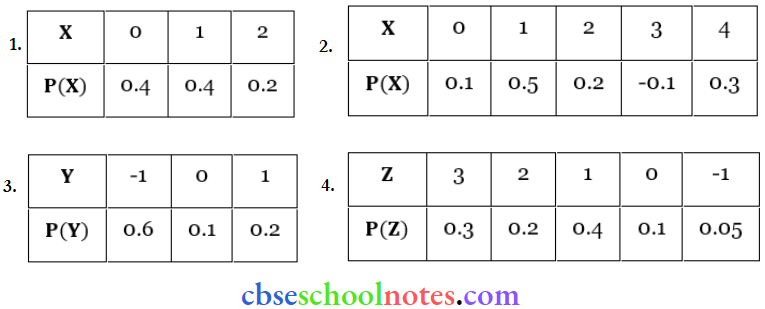
Solution:
It is known that the sum of all the probabilities in a probability distribution is one.
1. Sum of the probabilities = 0.4 + 0.4 + 0.2 = 1
Therefore, the given table is a probability distribution of random variables.
2. It can be seen that for X = 3, P (X) = -0.1
It is known that the probability of any observation is not negative. Therefore, the given table is not a probability distribution of random variables.
3. Sum of the probabilities .= 0,6 + 0.1 + 0.2 = 0.9 ≠ 1
Therefore, the given table is not a probability distribution of random variables,
4. Sum of the probabilities = 0.3 + 0,2 + 0.4 + 0.1 + 0.05 = 1.05 ≠ 1
Therefore, the given table is not a probability distribution of random variables.
Question 2. An urn contains 5 red and 2 black balls. Two balls are randomly drawn. Let X represent the number of black balls. What are the possible values of X? Is X a random variable?
Solution:
The two balls selected can be represented as BB, BR, RB, and RR, where B represents a black ball and R represents a red ball.
X represents the number of black balls.
∴ X(BB) = 2; X (BR) = 1; X (RB) = 1; X (RR) = 0
Therefore, the possible values of X are 0, 1, or 2.
Yes, X is a random variable.
Question 3. Let X represent the difference between the number of heads and the number of tails obtained when a coin is tossed 6 times. What are possible values of X?
Solution:
A coin is tossed six times and X represents the difference between the number of heads and the number of tails.
∴ X (6H, 0T) = |6-0| = 6; X (5H, IT) = |5 – 1| = 4
X (4H, 2T) = |4 – 2| = 2; X (3H, 3T) = |3 – 3| = 0
X (2H, 4T) = |2 – 4| = 2; X (1H, 5T) = |1 – 5| = 4
X (0H, 6T) = |0 – 6| = 6
Thus, the possible values of X are 6,4, 2 or 0.
Question 4. Find the probability distribution of
- Number of heads in two tosses of a coin
- Number of tails in the simultaneous tosses of three coins
- Number of heads in four tosses of a coin
Solution:
1. When one coin is tossed twice, the sample space is {HH, HT, TH, TT}
Let X represent the number of heads.
∴ X (HH) = 2, X (HT) = 1, X (TH) = 1, X (TT) = 0
Therefore, X can take the value of 0, 1, or 2.
It is known that,
P(HH) = P(HT) = P(TH) = P(TT} = \(\frac{1}{4}\)
P(X = 0) = P(TT) = \(\frac{1}{4}\)
P(X = 1) = P (HT) + P(TH) = \(\frac{1}{4}\) + \(\frac{1}{4}\) = \(\frac{1}{2}\)
P(X = 2) = P (HH) = \(\frac{1}{4}\)
Thus, the required probability distribution is as follows,
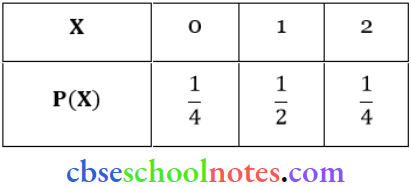
2. When three coins are tossed simultaneously, the sample space is {HHH, HHT, HTH HTT, THH, THT, TTH, TTT}
Let X represent the number of tails.
It can be seen that X can take the value of 0, 1, 2, or 3.
P (X = 0) = P (HHH) = \(\frac{1}{8}\)
P (X = 1) = P (HHT) + P (HTH) + P (THH) = \(\frac{1}{8}\) + \(\frac{1}{8}\) + \(\frac{1}{8}\) = \(\frac{3}{8}\)
P (X = 2) = P (HTT) + P (THT) + P (TTH) = \(\frac{1}{8}\) + \(\frac{1}{8}\) + \(\frac{1}{8}\) = \(\frac{3}{8}\)
P (X = 3) = P (TTT) = \(\frac{1}{8}\)
Thus, the probability distribution is as follows.
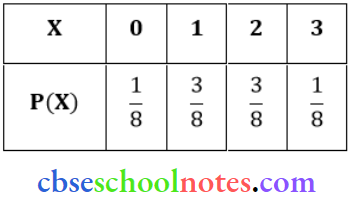
3. When a coin is tossed four times, the sample space is
S = {HHHH, HHHT, HHTH, HHTT, HTHT, HTHH, HTTH, HTTT, THHH, THHT, THTH, THTT, TTHH, TTHT, TTTH, TTTT}
Let X be the random variable, which represents the number of heads.
It can be seen that X can take the value of 0,1,2, 3, or 4,
P(X = 0) = P(TTTT) = \(\frac{1}{16}\)
p (X = 1) = p (TTTH) + p (TTHT) + P (THTT) + P (HTTT) = \(\frac{1}{16}\) + \(\frac{1}{16}\) + \(\frac{1}{16}\) + \(\frac{1}{16}\) = \(\frac{1}{4}\)
P(X = 2) = P (HHTT) + P (THHT) + P (TTHH) + p (IITTH) + p (HTHT) + P (THTH)
= \(\frac{1}{16}\) + \(\frac{1}{16}\) + \(\frac{1}{16}\) + \(\frac{1}{16}\) + \(\frac{1}{16}\) = \(\frac{1}{16}\) = \(\frac{6}{16}\) = \(\frac{3}{8}\)
P (X = 3) = P (HHHT) + P (HHTH) + P (HTHH) P (THHH)
= \(\frac{1}{16}\) + \(\frac{1}{16}\) + \(\frac{1}{16}\) = \(\frac{4}{16}\) = \(\frac{1}{4}\)
P (X = 4) = P(HHHH)’ = \(\frac{1}{16}\)
Thus, the probability distribution is as follows.
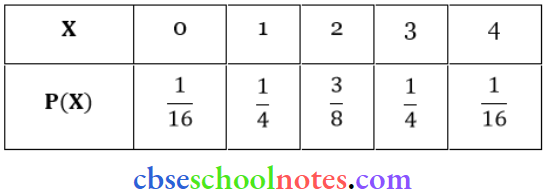
Question 5. Find the probability distribution of the number of successes in two tosses of a die, where success is defined as
- Number greater than 4
- Six appear on at least one die
Solution:
When a die is tossed two times, we obtain (6×6) = 36 number of observations.
Let X be the random variable, which represents the number of successes,
1. Here, success refers to the number greater than 4, X can take the value 0, 1 or 2.
P (X = 0) = P (a number less than or equal to 4 on both the tosses) = \(\frac{4}{6}\) x \(\frac{4}{6}\) = \(\frac{4}{9}\)
P (X = 1) = P (number less than or equal to 4 on first toss and greater than 4 on second toss) + P (number greater than 4 on first toss and less than or equal to 4 on second toss)
= \(\frac{4}{6}\) x \(\frac{2}{6}\) + \(\frac{4}{6}\) x \(\frac{2}{6}\) = \(\frac{4}{9}\)
P (X = 2) = P (number greater than 4 on both the tosses) = \(\frac{2}{6}\) x \(\frac{2}{6}\) = \(\frac{1}{9}\)
Thus, the probability distribution is as follows.
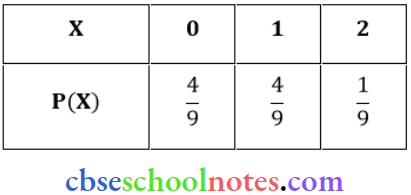
2. Here, success means six appears on at least one die, X can take the value 0 or 1.
P (X = 0) = P (six does not appear on any of the dice) = \(\frac{5}{6}\) x \(\frac{5}{6}\) = \(\frac{25}{36}\)
P (X = 1) = P (six appears on at least one of the dice).
Thus, the required probability distribution is as follows.
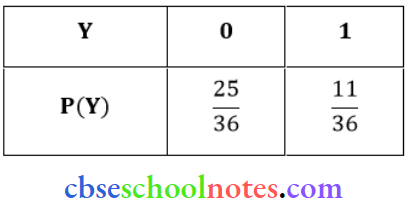
Question 6. From a lot of 30 bulbs which include 6 defectives, a sample of 4 bulbs is drawn at random with replacement. Find the probability distribution of the number of defective bulbs.
Solution:
It is given that out of 30 bulbs, 6 are defective.
⇒ Number of non-defective bulbs = 30 – 6 = 24
4 bulbs are drawn from the lot with replacement.
Let X be the random variable that denotes the number of defective bulbs In the selected bulbs, X can take the value 0, 1, 2, 3 or 4.
∴ P (X = 0) = P (4 non-defective and 0 defective) = \({ }^4 \mathrm{C}_0 \cdot \frac{4}{5} \cdot \frac{4}{5} \cdot \frac{4}{5} \frac{4}{5}=\frac{256}{625}\)
P (X = 1) = P (3 non-defective and 1 defective) = \({ }^4 \mathrm{C}_1 \cdot\left(\frac{1}{5}\right) \cdot\left(\frac{4}{5}\right)^3=\frac{256}{625}\)
P (x = 2) = P (2 non-defective and 2 detective) = \({ }^4 C_2 \cdot\left(\frac{1}{5}\right)^2 \cdot\left(\frac{4}{5}\right)^2=\frac{96}{625}\)
p (X = 3) = P(1 non-defective and 3 defective) = \({ }^4 \mathrm{C}_3 \cdot\left(\frac{1}{5}\right)^3 \cdot\left(\frac{4}{5}\right)=\frac{16}{625}\)
P (x = 4) = P (0 non-defective and 4 defective)= \({ }^4 \mathrm{C}_4 \cdot\left(\frac{1}{5}\right)^4 \cdot\left(\frac{4}{5}\right)^0=\frac{1}{625}\)
Therefore, the required probability distribution is as follows
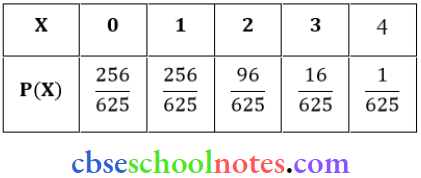
Question 7. A coin is biased so that the head is 3 times as likely to occur as the tail. If the coin is tossed twice, find the probability distribution of a number of tails.
Solution:
Let the probability of getting a tail in tossing one biased coin be x.
P (T) = x
⇒ P(H) = 3x
Now, P (T) + P (H) = 1
⇒ x + 3x = 1
⇒ 4x = l
x = \(\frac{1}{4}\)
∴ P (T) = \(\frac{1}{4}\) and P (H) = \(\frac{3}{4}\)
When the coin is tossed twice, the sample space is {HH, TT, HT, TH}.
Let X be the random variable representing the number of tails, Here ‘X’ can be 0, 1 or 2
∴ P(X = 0) – P (no tail) = P(H) x P(H) = \(\frac{3}{4} \times \frac{3}{4}=\frac{9}{16}\)
p (X= 1) = P (one tail) = P (HT) + P (TH) = \(\frac{3}{4} \cdot \frac{1}{4}+\frac{1}{4} \cdot \frac{3}{4}=\frac{3}{8}\)
P (X = 2) = P (two tails) = P (TT) = \(\frac{1}{4} \times \frac{1}{4}=\frac{1}{16}\)
Therefore, the required probability distribution is as follows.

Question 8. A random variable X has the following probability distribution. Determine

- k
- P (X < 3)
- P (X > 6)
- P (0 < X < 3)
Solution:
1. It is known that the sum of probabilities of a probability distribution of random variables is one.
∴ 0 + k + 2k + 2k + 3k + k² + 2k² + (7k² + k) = 1
⇒ 10k² + 9k – 1 = 0 ⇒(l0k-1)(k + 1) = 0
⇒ k = -1, \(\frac{1}{10}\)
k = -1 is not possible as the probability of an event is never negative.
∴ k = \(\frac{1}{10}\)
2. P (X < 3) = P (X – 0) + P (X = 1) + P (X = 2)
= \(0+\mathrm{k}+2 \mathrm{k}=3 \mathrm{k}=3 \times \frac{1}{10}=\frac{3}{10}\) (because \(\mathrm{k}=\frac{1}{10}\))
3. \(\mathrm{P}(\mathrm{X}>6)=\mathrm{P}(\mathrm{X}=7)=7 \mathrm{k}^2+\mathrm{k}=7 \times\left(\frac{1}{10}\right)^2+\frac{1}{10}=\frac{7}{100}+\frac{1}{10}=\frac{17}{100}\)
4. \(\mathrm{P}(0<\mathrm{X}<3)=\mathrm{P}(\mathrm{X}=1)+\mathrm{P}(\mathrm{X}=2)=\mathrm{k}+2 \mathrm{k}=3 \mathrm{k}=3 \times \frac{1}{10}=\frac{3}{10}\) (because \(\mathrm{k}=\frac{1}{10})\)
Question 9. The random variable X has probability distribution P(X) of the following form, where k is some number:
P(X) = \(=\left\{\begin{array}{cc}
k, & \text { if } x=0 \\
2 k, & \text { if } x=1 \\
3 k & \text { if } x=2 \\
0 & \text { otherwise }
\end{array}\right.\)
- Determine the value of k.
- Find P(X < 2), P(X ≤ 2), P(X ≥ 2).
Solution:
1. It is known that the sum of probabilities of a probability distribution of random variables is one.
∴ k + 2k + 3k + 0 = 1 6k = 1 ⇒ k = \(\frac{1}{6}\)
2. P(X < 2) = P(X = 0) + P(X = l) = k + 2k = 3k = \(\frac{3}{6}\) = \(\frac{1}{2}\)
P(X ≤ 2) = P(X = 0) + P(X = 1) + P (X = 2) = k + 2k + 3k + 6k = \(\frac{6}{6}\) = 1
P(X ≥ 2) = P(X = 2) + P (X > 2) = 3k + 0 = 3k = \(\frac{3}{6}\) = \(\frac{1}{2}\)
Question 10. Find the mean number of heads in three tosses of a fair coin.
Solution:
Let X denote the success of getting heads.
Therefore, the sample space is S = {HHH, HHT, HTH, HTT, THH, THT, TTH, TTT} It can be seen that X can take the value of 0, 1, 2 or 3.
P(X = 0) = P (TTT) = \(\frac{1}{8}\)
P(X = 1) = P(getting one head and two tails)
= P(TTH} + P{THT} + P{HTT} = \(\frac{1}{8}\) + \(\frac{1}{8}\) + \(\frac{1}{8}\) = \(\frac{3}{8}\)
P(X = 2) = P (getting 2 head and 1 tail)
= P(HHT) + P (HTH) + P(THH) = \(\frac{1}{8}\) + \(\frac{1}{8}\) + \(\frac{1}{8}\) = \(\frac{3}{8}\)
P(X = 3) = P(HHH) = \(\frac{1}{8}\)
Therefore, the required probability distribution is as follows.
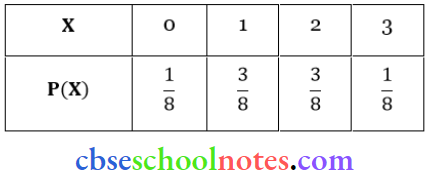
Mean \(\mu=\Sigma X_i P\left(X_i\right)=0 \times \frac{1}{8}+1 \times \frac{3}{8}+2 \times \frac{3}{8}+3 \times \frac{1}{8}=\frac{3}{8}+\frac{3}{4}+\frac{3}{8}=\frac{3}{2}=1.5\)
Question 11. Two dice are thrown simultaneously. If X denotes the number of sixes, find the expectation of X.
Solution:
Here, X represents the number of sixes obtained when two dice are thrown simultaneously.
Therefore, X can take the value of 0, 1 or 2.
∴ P(X = 0) = P (not getting six on any of the dice) = \(\frac{25}{36}\)
P(X = 1) = P (six on first die and no six on second die) + P (no six on first die and six on second die) \(\frac{1}{6} \times \frac{5}{6}+\frac{1}{6} \times \frac{5}{6}=2\left(\frac{1}{6} \times \frac{5}{6}\right)=\frac{10}{36}\)
P (X = 2) = P (six on both the dice) = \(\frac{1}{36}\)
Therefore, the required probability distribution is as follows.
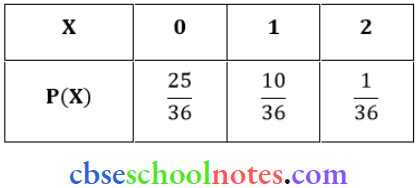
Then, expectation of X = \(E(X)=\sum X_i P\left(X_i\right)=0 \times \frac{25}{36}+1 \times \frac{10}{36}+2 \times \frac{1}{36}=\frac{1}{3}\)
Question 12. Two numbers are selected at random (without replacement) from the first six positive integers. Let X denote the larger of the two numbers obtained. Find E(X).
Solution:
The two positive integers can be selected from the first six positive integers without replacement in 6 x 5 = 30 ways.
X represents the larger of the two numbers obtained. Therefore, X can hike the value of 2,3,4, 5 or 6.
For X = 2, the possible observations are (1, 2) and (2, 1).
∴ P(X = 2) = \(\frac{2}{30}\) = \(\frac{1}{15}\)
For X = 3, the possible observations are (1,3), (2, 3), (3,1) and (3,2).
∴ P(X = 3) = \(\frac{4}{30}\) = \(\frac{2}{15}\)
For X = 4, the possible observations are (1, 4), (2, 4), (3, 4), (4, 3), (4, 2) and (4, 1).
∴ P(X = 4) = \(\frac{6}{30}\) = \(\frac{3}{15}\)
For X = 5, the possible observations are (1, 5), (2, 5), (3, 5), (4, 5), (5,4), (5, 3), (5,2) and (5,1).
∴ P(X = 5) = \(\frac{8}{30}\) = \(\frac{4}{15}\)
For X = 6, the possible observations are (1, 6), (2, 6), (3, 6), (4, 6), (5, 6), (6, 5), (6, 4), (6, 3), (6, 2) and (6. 1).
∴ P(X = 6) = \(\frac{10}{30}\) = \(\frac{1}{3}\)
Therefore, the required probability distribution is as follows.
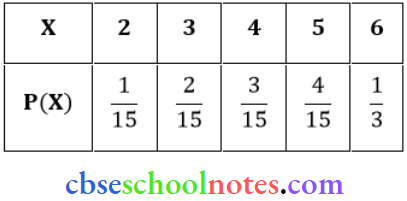
Then, \(E(X)=\Sigma X_i P\left(X_i\right)=2 \cdot \frac{1}{15}+3 \cdot \frac{2}{15}+4 \cdot \frac{1}{5}+5 \cdot \frac{4}{15}+6 \cdot \frac{1}{3}\)
= \(\frac{2}{15}+\frac{2}{5}+\frac{4}{5}+\frac{4}{3}+2=\frac{70}{15}=\frac{14}{3}\)
Choose The Correct Answer
Question 13. The mean of the numbers obtained on throwing a die having written 1 on three faces, 2 on two faces and 5 on one face is
- 1
- 2
- 5
- 8/3
Solution:
Let X be the random variable representing a number on the die. Here X can be 1,2 or 5
The total number of observations is six.
∴ P(X=1) = \(\frac{3}{6}=\frac{1}{2}\)
P(X=2) = \(\frac{2}{6}=\frac{1}{3}\)
P(X=5) = \(\frac{1}{6}\)
Therefore, the probability distribution is as follows:
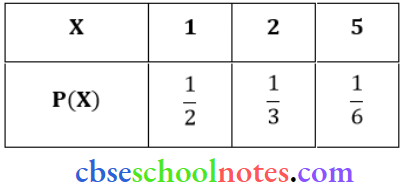
Mean = \(E(X)=\Sigma X_i P\left(X_i\right)=1 \times \frac{1}{2}+2 \times \frac{1}{3}+5 \times \frac{1}{6}=\frac{1}{2}+\frac{2}{3}+\frac{5}{6}=\frac{3+4+5}{6}=\frac{12}{6}=2\)
Question 14. Suppose that two cards are drawn at random from a deck of cards. Let X be the number of aces obtained. Then the value of E(X) is
- \(\frac{37}{221}\)
- \(\frac{5}{13}\)
- \(\frac{1}{13}\)
- \(\frac{2}{13}\)
Solution:
Let X denote the number of aces obtained. Therefore, X can take any of the values of 0, 1, or 2.
In a deck of 52 cards, 4 cards are aces. Therefore, there are 48 non-ace cards.
∴ P (X = 0) = P (0 ace and 2 non-ace cards)
= \(\frac{{ }^4 \mathrm{C}_0 \times{ }^{48} \mathrm{C}_2}{{ }^{52} \mathrm{C}_2}=\frac{1128}{1326}\)
P(X=1) = P(1 ace and 1 non-ace cards)
= \(\frac{{ }^4 \mathrm{C}_1 \times{ }^{48} \mathrm{C}_1}{{ }^{52} \mathrm{C}_2}=\frac{192}{1326}\)
P(X=2)=P(2 ace and 0 non- ace cards)
= \(\frac{{ }^4 \mathrm{C}_2 \times{ }^{48} \mathrm{C}_6}{{ }^{57} \mathrm{C}_2}=\frac{6}{1326}\)
Thus, the probability distribution is as follows.
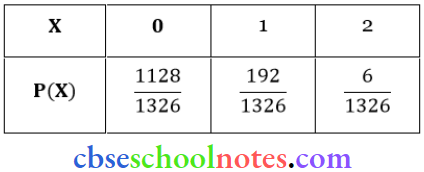
Then, \(E(X)=\Sigma P\left(X_i\right) \cdot X_i=0 \times \frac{1128}{1326}+1 \times \frac{192}{1326}+2 \times \frac{6}{1326}=\frac{204}{1326}=\frac{2}{13}\)
Therefore, the correct answer is (4).
Probability Miscellaneous Exercise
Question 1. A and B are two events such that P(A)≠0.Find P(B | A), If
- A is a subset of B
- A∩B = ø
Solution:
It is given that. P (A) ≠ 0
1. Given A is a subset of B
⇒ \(A \cap B=A \text { i.e. }(A \subset B)\)
∴ \(P(A \cap B)=P(B \cap A)=P(A)\)
∴ \(P(B \mid A)=\frac{P(B \cap A)}{P(A)}=\frac{P(A)}{P(A)}=1\)
2. \(\mathrm{A} \cap \mathrm{B}=\phi \Rightarrow \mathrm{P}(\mathrm{A} \cap \mathrm{B})=0\)
∴ \(P(B \mid A)=\frac{P(A \cap B)}{P(A)}=0\)
Question 2. A couple has two children,
- Find the probability that both children are males, if it is known that at least one of the children is male,
- Find the probability that both children are females if it is known that the elder child is a female.
Solution:
If a couple has two children, then the sample space is S = |(b,b),(b,g),(g.b),(g,g)|
1. Let E and F respectively denote the events that both children are males and at least one of the children is a male.
∴ \(\mathrm{E} \cap \mathrm{F}=\{(\mathrm{b}, \mathrm{b})\} \Rightarrow \mathrm{P}(\mathrm{E} \cap \mathrm{F})=\frac{1}{4}\)
∴ \(\mathrm{P}(\mathrm{E})=\frac{1}{4} ; \mathrm{P}(\mathrm{F})=\frac{3}{4} \Rightarrow \mathrm{P}(\mathrm{E} \mid \mathrm{F})=\frac{\mathrm{P}(\mathrm{E} \cap \mathrm{F})}{\mathrm{P}(\mathrm{F})}=\frac{\frac{1}{4}}{\frac{3}{4}}=\frac{1}{3}\)
2. Let A and B respectively denote the events that both children are females and the elder child is a female.
A = \(\{(g, g)\} \Rightarrow P(A)=\frac{1}{4}, B=\{(g, b),(g, g)\} \Rightarrow P(B)=\frac{2}{4}\)
A \(\cap B=\{(g, g)\} \Rightarrow P(A \cap B)=\frac{1}{4}\)
P\((A \mid B)=\frac{P(A \cap B)}{P(B)}=\frac{\frac{1}{4}}{\frac{2}{4}}=\frac{1}{2}\)
Question 3. Suppose that 5% of men and 0.25% of women have grey hair. A grey-haired person is selected at random. What is the probability of this person being male? Assume that there are equal numbers of males and females.
Solution:
Let E1 and E2 be the events of male and female persons respectively.
∴ P(E1) = 0.5 and P(E2) = 0.5
Let A be the event of a grey-hair person
⇒ P(A | E1) = Probability of selected a grey-haired male = 5% = 0.05
⇒ P(A | E2) = Probability of selected a grey-haired female = 0.25% = 0.0025
The probability of the person selected is male if the person is grey-haired
i.e. \(P\left(E_1 | A\right)=\frac{P\left(E_1\right) \cdot P\left(A | E_1\right)}{P\left(E_1\right) \cdot P\left(A \mid E_1\right)+P\left(E_2\right) \cdot P\left(A | E_2\right)}\)
= \(\frac{0.5 \times 0.05}{0.5 \times 0.0025+0.5 \times 0.05}\)
= \(\frac{0.5 \times 0.05}{0.5[0.0025+0.05]}\)
= \(\frac{0.05}{0.0525}=\frac{500}{525}=\frac{20}{21}\)
Question 4. Suppose that 90% of people are right-handed. What is the probability that at most 6 of a random sample of 10 people are right-handed?
Solution:
A person can be either right-handed or left-handed.
It is given that 90% of the people are right-handed.
∴ p = P (Right-handed) = \(\frac{9}{10}\)
q = P (Left-handed) = 1 – \(\frac{9}{10}\) = \(\frac{1}{10}\)
Using the binomial distribution, the probability that more than 6 people are right-handed is given by,
⇒ \(\sum_{\mathrm{r}=7}^{10}{ }^{10} \mathrm{C}_{\mathrm{r}} \mathrm{p}^{\mathrm{T}} \mathrm{q}^{\mathrm{n}-\mathrm{r}}=\sum_{\mathrm{r}=7}^{10}{ }^{10} \mathrm{C}_{\mathrm{r}}\left(\frac{9}{10}\right)^{\mathrm{r}}\left(\frac{1}{10}\right)^{10-\mathrm{r}}\)
Therefore, the probability that at most 6 people are right-handed
= 1-P More than 6 are right-handed
= \(1-\sum_{r=7}^{10}{ }^{10} \mathrm{C}_r(0.9)^r(0.1)^{10-r}\)
Question 5. If a leap year is selected at random, what is the chance that it will contain 53 Tuesdays?
Solution:
In a leap year, there are 366 days, i.e., 52 weeks and 2 days.
In 52 weeks, there are 52 Tuesdays.
Therefore, the probability that the leap year will contain 53
Tuesdays is equal to the probability that one of the remaining 2 days will be Tuesdays.
The remaining 2 days can be S = {Monday Tuesday, Tuesday Wednesday, Wednesday Thursday,
Thursday Friday, Friday Saturday, Saturday Sunday, Sunday Monday}
⇒ n(S) = 7
Favourable cases F = {(Monday, Tuesday), (Tuesday, Wednesday)}
⇒ n(F) = 2
Probability that a leap year will have 53 Tuesdays = \(\frac{2}{7}\)
Question 6. Suppose we have four boxes. A, B, C and D containing coloured marbles as given below:
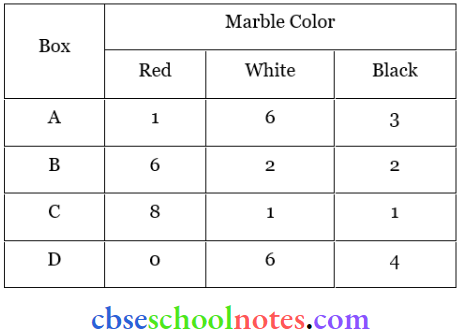
One of the boxes has been selected at random and a single marble is drawn from it. If the marble is red, what is the probability that it was drawn from box A?, box B?, or box C?
Solution:
Let R be the event of drawing the red marble
Let EA, EB and EC respectively denote the events of selecting the boxes A, B and C.
Total number of marbles = 40
Number of red marbles = 15
∴ P(R) = \(\frac{15}{40}\) = \(\frac{3}{8}\)
The probability of drawing the red marble from box A is given by P(EA|R).
∴ \(P\left(E_A \mid R\right)=\frac{P\left(E_A \cap R\right)}{P(R)}=\frac{\frac{1}{40}}{\frac{3}{8}}=\frac{1}{15}\)
The probability that the red marble is from box B is P(EB|R)
∴ \(P\left(E_B \mid R\right)=\frac{P\left(E_B \cap R\right)}{P(R)}=\frac{\frac{6}{40}}{\frac{3}{8}}=\frac{2}{5}\)
The probability that the red marble is from box C is P(EC|R)
∴ \(P\left(E_C \mid R\right)=\frac{P\left(E_C \cap R\right)}{P(R)}=\frac{\frac{8}{40}}{\frac{3}{8}}=\frac{8}{15}\)
Question 7. Assume that the chances of the patient having a heart attack are 40%. It is also assumed that a meditation and yoga course reduces the risk of heart attack by 30% and prescription of certain drugs reduces its chances by 25%. At a time a patient can choose any one of the two options with equal probabilities. It is given that after going through one of the two options the patient selected at random suffers a heart attack. Find the probability that the patient followed a course of meditation and yoga.
Solution:
Let E1 and E2 denote the events that the selected person followed the course of yoga and meditation, and the person adopted the drug prescription, respectively
∴ P(E1) = P(E2) = \(\frac{1}{2}\)
Let A be the event that person has a heart attack
∴ P(A) = 0.40
P(A|E1) = 0.40×0.70 = 0.28
P(A|E2) = 0.40X0.75 = 0.30
The probability that the patient suffering a heart attack followed a course of meditation and yoga is given by P(E1|A).
⇒ \(\mathrm{P}\left(\mathrm{E}_1 \mid \mathrm{A}\right)=\frac{\mathrm{P}\left(\mathrm{E}_1\right) \mathrm{P}\left(\mathrm{A} \mid \mathrm{E}_1\right)}{\mathrm{P}\left(\mathrm{E}_1\right) \mathrm{P}\left(\mathrm{A} \mid \mathrm{E}_1\right)+\mathrm{P}\left(\mathrm{E}_2\right) \mathrm{P}\left(\mathrm{A} \mid \mathrm{E}_2\right)}\)
= \(\frac{\frac{1}{2} \times 0.28}{\frac{1}{2} \times 0.28+\frac{1}{2} \times 0.30}=\frac{14}{29}\)
Question 8. If each element of a second-order determinant is either zero or one, what is the probability that the value of the determinant is positive? (Assume that the individual entries of the determinant are chosen independently, each value being assumed with probability \(\frac{1}{2}\)).
Solution:
The total number of determinants of second order with each element being 0 or 1 is (2)4 =16
The value of the determinant is positive in the following cases, \(\left\{\left|\begin{array}{ll}
1 & 0 \\
0 & 1
\end{array}\right|,\left|\begin{array}{ll}
1 & 1 \\
0 & 1
\end{array}\right|,\left|\begin{array}{ll}
1 & 0 \\
1 & 1
\end{array}\right|\right\}\)
Required probability = \(\frac{3}{16}\)
Question 9. An electronic assembly consists of two subsystems, say A and B. From previous testing procedures, the following probabilities are assumed to be known:
- P (A fails) = 0.2
- P (B fails alone) = 0,15
- P (A and B fail) = 0.15
Evaluate the following probabilities
- P (A fails | B has failed)
- P (A fails alone)
Solution:
Let the event in which A fails and B fails to be denoted by EA and EB.
P(EA)=0.2
P(EA∩EB) = 0.15
P (B fails alone) = P (EB) – P(EA∩EB)
∴ 0.15 = P(EB)-0.15
⇒ P(EB) = 0.3
- \(P\left(E_A \mid E_B\right)=\frac{P\left(E_A \cap E_B\right)}{P\left(E_B\right)}\) = \(\frac{0.15}{0.3}=0.5\)
- \(\mathrm{P}(\mathrm{A} \text { fails alone })=\mathrm{P}\left(\mathrm{E}_{\mathrm{A}}\right)-\mathrm{P}\left(\mathrm{E}_{\mathrm{A}} \cap \mathrm{E}_{\mathrm{B}}\right)\) =0.2-0.15=0.05
Question 10. Bag 1 contains 3 red and 4 black balls and Bag 2 contains 4 red and 5 black balls. One ball is transferred from Bag 1 to Bag 2 and then a ball is drawn from Bag 2. The ball so drawn is found to be red in colour. Find the probability that the transferred ball is black.
Solution:
Let E1 and E2 respectively denote the events that a red ball is transferred from bag 1 to 2 and a black ball is transferred from bag 1 to 2.
⇒ \(\mathrm{P}\left(\mathrm{E}_1\right)=\frac{3}{7} \text { and } \mathrm{P}\left(\mathrm{E}_2\right)=\frac{4}{7}\)
Let A be the event that the ball drawn is red.
When a red ball is transferred from bag 1 to 2, \(\mathrm{P}\left(\mathrm{A} \mid \mathrm{E}_1\right)=\frac{5}{10}=\frac{1}{2}\)
When a black ball Is transferred from bag 1 to 2, \(\mathrm{P}\left(\mathrm{A} \mid \mathrm{E}_2\right)=\frac{4}{10}=\frac{2}{5}\)
The probability that the transferred ball is black in colour when the ball is drawn is red in colour is given by P(E2|A)
By using Baye’s theorem, we obtain
∴ \(P\left(E_2 \mid A\right)=\frac{P\left(E_2\right) P\left(A \mid E_2\right)}{P\left(E_1\right) P\left(A \mid E_1\right)+P\left(E_2\right) P\left(A \mid E_2\right)}\)
= \(\frac{\frac{4}{7} \times \frac{2}{5}}{\frac{3}{7} \times \frac{1}{2}+\frac{4}{7} \times \frac{2}{5}}=\frac{16}{31}\)
Choose The Correct Answer
Question 11. If A and B are two events such that \(P(A) \neq 0\) and \(P(B \mid A)=1\), then.
- \(\mathrm{A} \subset \mathrm{B}\)
- \(\mathrm{B} \subset \mathrm{A}\)
- \(\mathrm{B}=\phi\)
- \(\mathrm{A}=\phi\)
Solution: 1. \(\mathrm{A} \subset \mathrm{B}\)
P\((\mathrm{A}) \neq 0\) and \(\mathrm{P}(\mathrm{B} \mid \mathrm{A})=1\)
Now, \(\mathrm{P}(\mathrm{B} \mid \mathrm{A})=\frac{\mathrm{P}(\mathrm{B} \cap \mathrm{A})}{\mathrm{P}(\mathrm{A})}\)
1 = \(\frac{P(B \cap A)}{P(A)}\)
⇒ \(P(A)=P(B \cap A) \Rightarrow A \subset B\)
Thus, the correct answer is 1.
Question 12. If P\((\mathrm{A} \mid \mathrm{B})>\mathrm{P}(\mathrm{A})\), then which of the following is correct:
- \(\mathrm{P}(\mathrm{B} \mid \mathrm{A})<\mathrm{P}(\mathrm{B})\)
- \(\mathrm{P}(\mathrm{A} \cap \mathrm{B})<\mathrm{P}(\mathrm{A}) \cdot \mathrm{P}\)
- \(\mathrm{P}(\mathrm{B} \mid \mathrm{A})>\mathrm{P}(\mathrm{B})\)
- \(\mathrm{P}(\mathrm{B} \mid \mathrm{A})=\mathrm{P}(\mathrm{B})\)
Solution: 3. \(\mathrm{P}(\mathrm{B} \mid \mathrm{A})>\mathrm{P}(\mathrm{B})\)
⇒ \(\mathrm{P}(\mathrm{A} \mid \mathrm{B})>\mathrm{P}(\mathrm{A})\)
⇒ \(\frac{P(A \cap B)}{P(B)}>P(A)\)
⇒ \(P(A \cap B)>P(A) \cdot P(B)\)
⇒ \(\frac{P(A \cap B)}{P(A)}>P(B)\)
⇒ \(P(B \mid A)>P(B)\)
Thus, the correct answer is (3).
Question 13. If A and B are any two events such that P (A) + P (B) – P (A and B) = P (A), then
- P (B|A) = 1
- P (A]B) = 1
- P (B|A) = 0
- P (A|B) = 0
Solution:
P (A) + P (B) – P (A and B) = P(A)
⇒ P(A) + P(B)-P(A∩B)=P(A)
⇒ P(B)-P(A∩B) = 0
⇒ P(A∩B)=P(B)
Thus, the correct answer is (2).
